In this article, I’m going to share the lessons we learned from losing 35% of our monthly revenue and how shifting our marketing agency’s business model, we went on to close 189 clients in just 2 years and generate $720,000 in annual revenue.
But before we get started, if you’re looking for a quiz maker, we hope that you’ll give LeadQuizzes a shot 😉
Now let’s jump into it!
We started our web development/marketing agency, Yazamo in January 2012.
We didn’t have a predictable way of generating leads outside of referrals and networking and so for years, we would take any kind of work we could get.
We offered services like web design and development, advertising on Facebook, Google, and LinkedIn, landing page creation, copywriting, marketing automation, shopping cart customization, the whole gamut.
We thought we needed to solve every digital marketing problem for our customers and so we liked saying that we were a ‘full-service’ marketing agency. Under the surface, however, we had major problems.
❌ We struggled to get consistent results for clients because they were all different.
❌ We couldn’t develop effective employee training because everything was custom.
❌ This meant we struggled to scale beyond the projects my business partner and I could personally manage.
❌ And we didn’t have KPI’s that told us how successful our employees were when every project was different.
Being we didn’t have predictability in our model, we had to make up for things by just working harder. We eventually got a few big clients and were able to show off some big results.
With these big results under our belt, we thought the best way to scale would be to raise our prices. And so that was our strategy. We started asking clients to pay us anywhere from $3,500/month up to $10,000/month.
But with higher prices, came greater expectations.
And greater risk.
Unfortunately, we didn’t see the iceberg we were steering our ship into.
In 2015, we lost 3 clients that accounted for 35% of our monthly revenue.
Ouch.
To make it worse, we couldn’t replace them because we had a weak lead generation model at best.
So we went from healthy profits to five figure losses over night. We didn’t want to fire the employees we spent so much time recruiting and training, however in retrospect, that is exactly what we should have done because we ended up losing over $100,000.
We had to make a change.
✅ We wanted to be in control of our own lead generation.
✅ We wanted to be able to get consistent results for clients.
✅ We wanted to productize our service so that we didn’t have to spend a lot of time developing proposals.
✅ We wanted to be able to work with a larger number of clients at a lower price so that no one client would become a huge risk for our business.
✅ And we wanted to be able to easily train our team and really scale our business.
Over the next two years, we went on to do exactly that.
We went from closing maybe a couple client a month to closing two to three clients a week. 189 clients to be exact, which helped us grow our marketing agency to $720,000 a year in revenue.
If you’re ready to make a change and really scale your marketing agency, this guide is going to show you step-by-step exactly what we did.
Yes, it’s going to take a lot of hard work but if you can commit to our process, I can tell you that;
- You will feel better about the value you create for your clients.
- You’ll feel more in control of your destiny.
- You’ll have the freedom to step out of the day-to-day operations of your business.
- And you’ll have more financial freedom to do whatever you want.
Forewarning, this is a 17k+ word article.
I don’t want that to scare you so here’s some responses and feedback about this article to help convince you it’s worth reading 😉
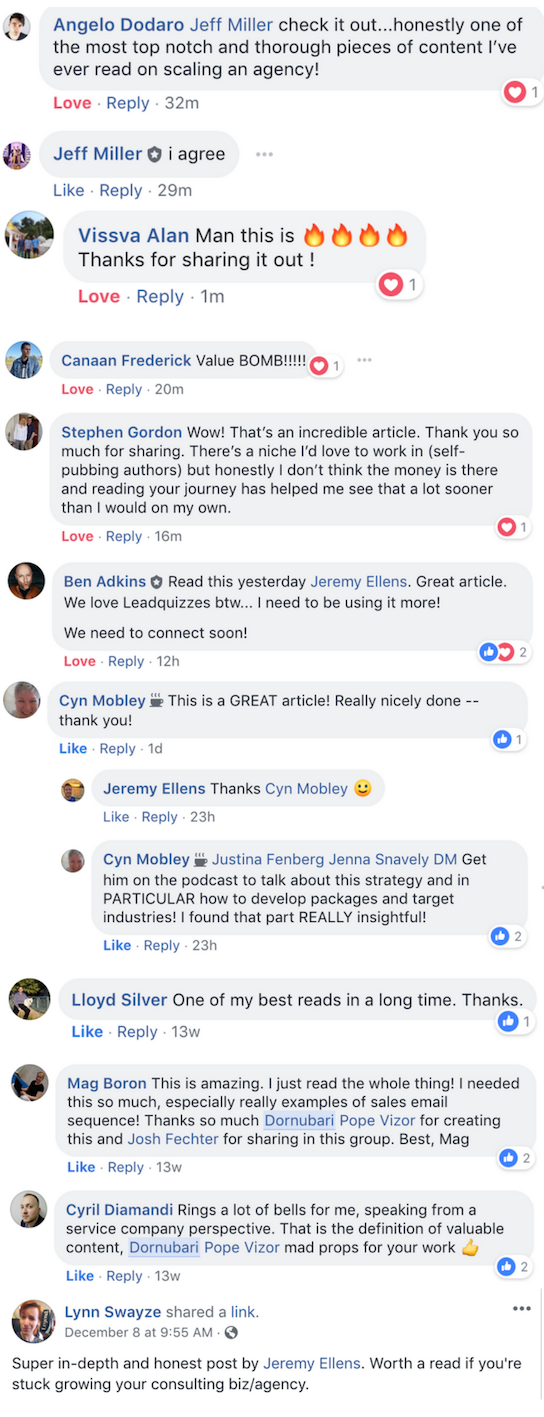
I’m going to include a table of contents for you to come back to and reference and I suggest you bookmark this page as well.
Section 1: Choosing Your Niche
Choosing a niche and productizing your service is one of the most important things you will do.
I can’t emphasize this enough.
It’s the foundation of your entire business.
If you haven’t chosen a niche yet or productized your service, you may think it’s not that big of a deal, but I’m here to tell you this was one of the most important things we did when scaling our marketing agency, and something I wish we paid a lot more attention to early on.
Here are the three steps you need to follow to accomplish this:
1. Choose an Industry
After we had lost three major clients and 35% of our monthly revenue in 2015, we looked back at what had worked well.
We had one case study under our belt where we used a quiz to generate over 35,000 leads, very inexpensively for a hormone doctor that had never built an email list before.
It was a quantum leap for her in lead generation.
At this point out of desperation, we decided we wanted to see if we could repeat those results with other clients.
We weren’t extremely strategic about picking an industry when we started but thankfully we fell into one. We happened to get a lot of our first clients in the health space and found that we could get repeatable results there so that’s an industry we came to specialize in.
Because we specialized, we got really good at running ads in those industries.
We could tell our clients with a pretty high confidence what range their lead cost would fall in. With that number in mind, we could do the math for them to see if they would get enough sales to make their campaign work.
Most of our clients prior to working with us were generating under 100 leads a month. After we started working with them, about 90-95% of our clients were able to generate 1,000+ leads a month at less than $1/lead.
Here’s an example of some of them:
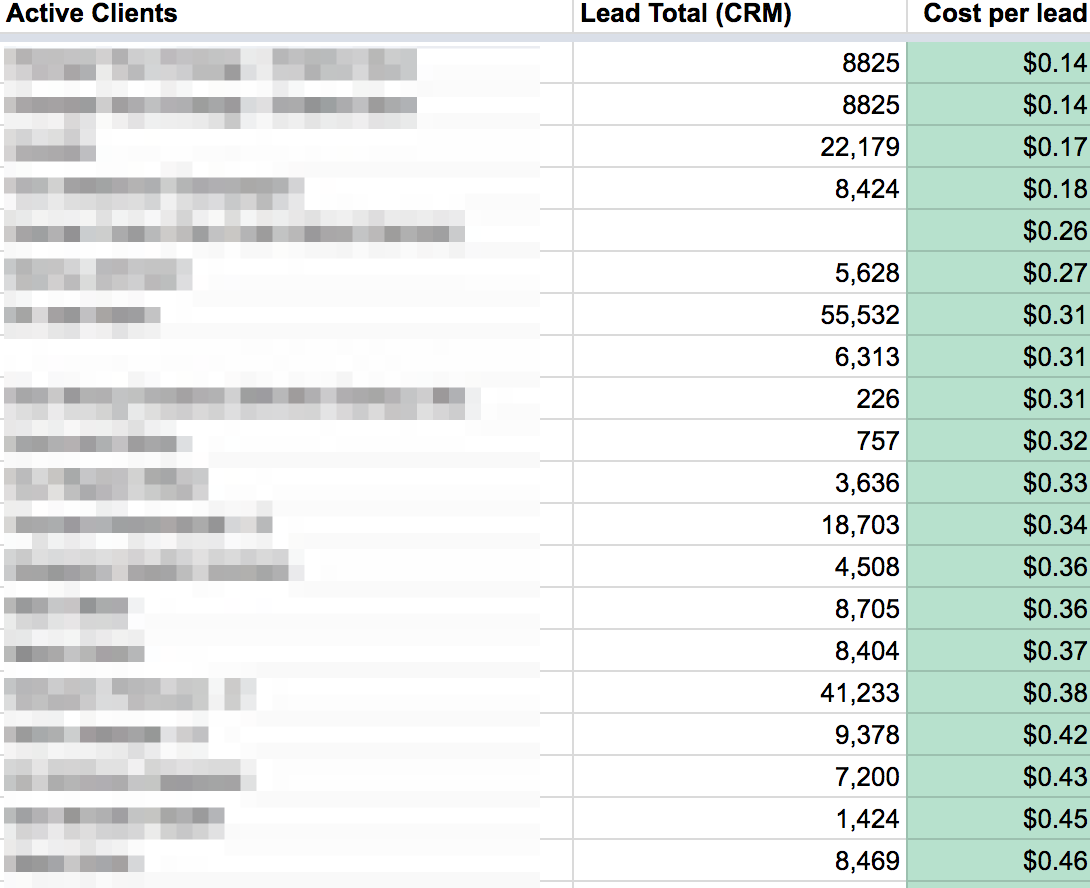
Now while this is a 10x improvement for most clients and a game changer for many, we found some were good at closing those leads but many were not.
The ones that were good at closing their leads have been clients for over 3 years. The ones that weren’t great at closing their leads lost patience quickly. If they didn’t learn how to close their leads then they assumed their leads were worthless and would cancel after 3-4 months.
A client that lasts 4 months compared to 3 years if you’re charging $1,000/month is $4,000 vs $36,000+.
With the system we are about to teach you, you will be able to close hundreds of clients but I want you to have long-term, recurring customers that aren’t churning out as quickly as you are closing them. This will be the difference between you loving your agency and feeling like you are back on the rat wheel.
Which leads us to the next thing you must do in choosing your niche…
2. Choose a Profession and Go Deep
Obviously, once you sign up a new client, you want them to continue to pay you for a very long period of time. But if they can’t close the leads you send them, what can you do?
Let’s look at the health space.
There are a TON of professions you could decide to focus on. For example, you have:
- Doctors
- Chiropractors
- Naturopathics
- Health coaches
- Dentists
- Nutritionist
- Gym owners
- Personal trainers
- eCommerce health business
- Etc.
We didn’t know what would work so we took the shotgun approach and tested quizzes with a lot of these different professions.
For the far majority of clients we got very positive leads costs, however, all of these professions have different sales models.
For instance, a doctor may want to sign up new patients for their clinic. So after their quiz, they need to get their lead to schedule a call, come in for a consultation, and enroll them in the clinic.
But there are a lot of areas that leads can drop out of this sales funnel.
For example:
What offer should the doctor use to incentivize a consultation call? What script should their staff use on the phone to ensure that lead comes in for a consultation? What kind of email and text reminder sequences and incentives should be put in place to make sure they show up? Is there a special introductory price that most leads will be willing to pay? Etc.
The clients that generated sales had systems in place for this already or we had to help teach them. The ones that didn’t were quick to say this didn’t work for them or the leads were ‘unqualified’ because they didn’t effortlessly become customers.
Most clients will be willing to try what you tell them to do if you can help them increase their sales.
But how can you know how to provide all of this sales information if you don’t specialize?
For example, let’s say you choose to also help eCommerce health businesses.
To generate sales, the eCommerce funnel might require a free + shipping offer at the end of the quiz to get their credit card, and then immediately a series of 3-4 upsells. Maybe they need a small retargeting budget for leads that started to buy but decided not to. Maybe their sales page needs some major improvements in terms of urgency, social proof, and better product descriptions. Maybe they need help with their email campaign to send promotional offers to leads that don’t buy?
As you can see different professions have drastically different sales models so picking one profession and sticking with it will allow you to help them answer these questions and create templates you can plug in with each new client.
Let’s take this a step further.
Using hypothetical numbers, if we exclusively specialized with naturopathic doctors, I could go to a naturopathic doctor and say, “We’re very confident that if we create a hormone quiz for people struggling with weight loss and advertise it on Facebook, your lead cost will be in the range of $1.00-$1.50/lead.
“Normally if you offered a free consultation to help people with their quiz results, you would get 5% to schedule BUT if you additionally offer a free eBook we created on how to optimize your hormones and a coupon for a free ($200 value) food intolerance test for new customers, your consult calls will double to 10%.”
“Then typically only 40% will show up to those calls unless you install our email and text message autoresponder system, which increases show up rate to 50%.”
“From there if your front desk follows a script I give you, you will get 80% to come in for a consultation.”
“And if you follow the closing process I layout, 50% will become patients worth $1,200/year.”
“So with $1,000 in ad spend, our average client that implements our process sees an increase of 20 new patients a month worth $24,000 in new revenue their first year, not including referrals.”
“And all it costs you is $2,000 ($1,000/month in ad spend and $1,000/month in management fee).”
Do you think that sounds compelling?
For each small incremental improvement you can make in their sales funnel, you compound the effectiveness you will have. Specialization is the key to being able to make these improvements.
For the doctors we worked with, we were able to create predictability like this:
Rejuv Medical – $18,000 in 1.5 months
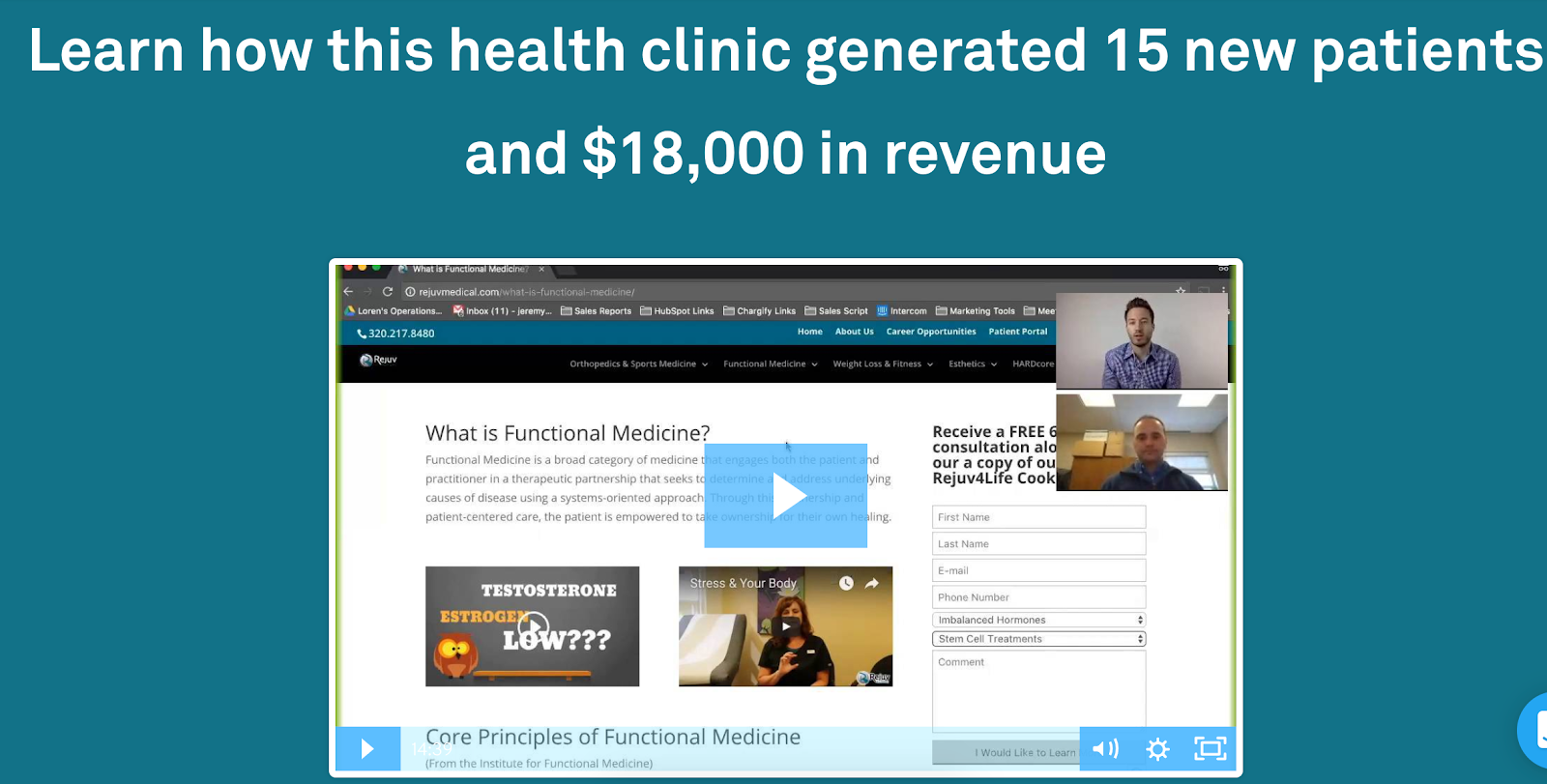
Integrative Health – $34,200/month in new sales
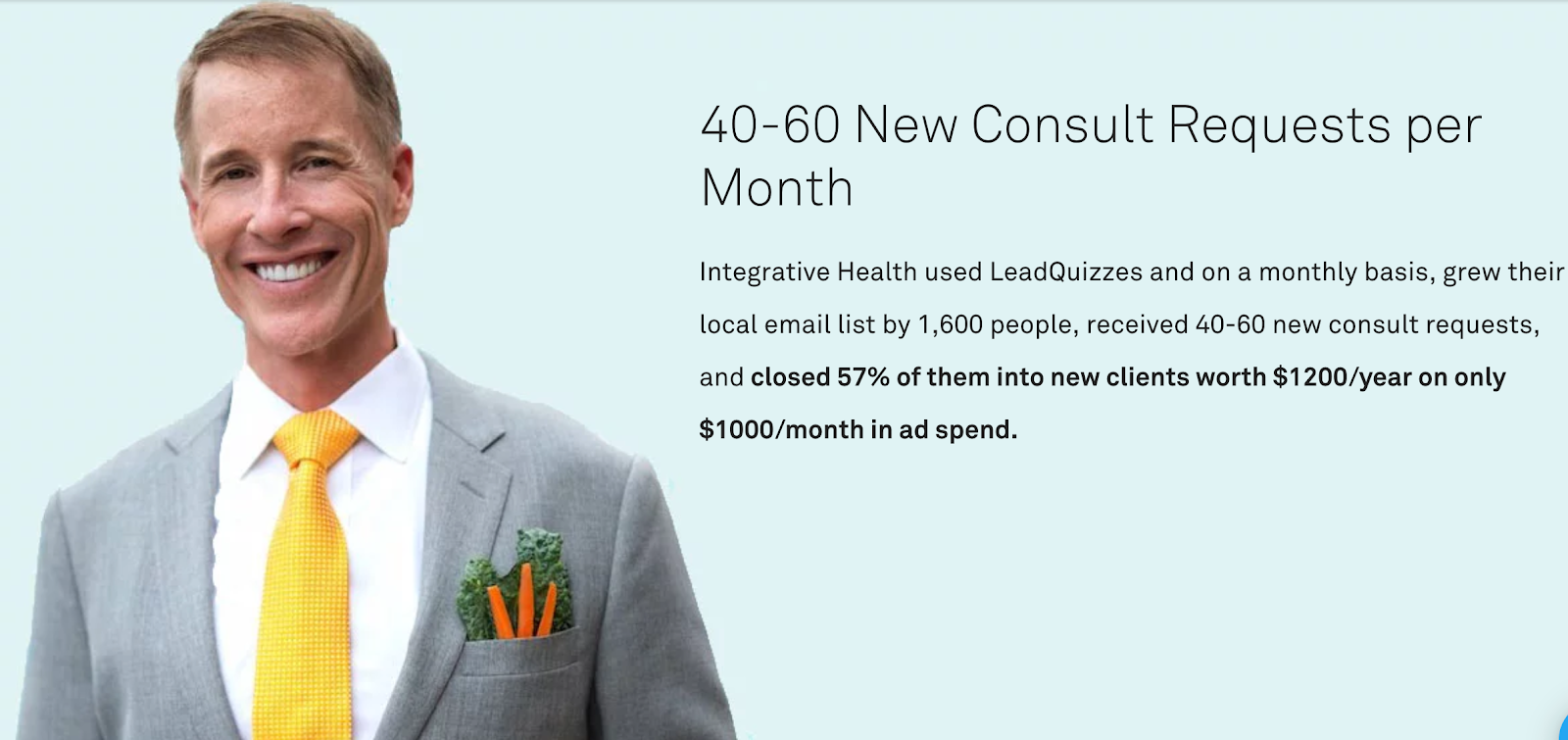
While we coached the above doctors on some of these sales strategies, if we worked exclusively with naturopathic doctors, I think we could have created plug and play systems like I just described to dramatically increase all of our client’s results and the lifetime value we earned from them.
Beyond better results for your clients, longer client retention, and more confidence and certainty you will bring to sales calls, specializing will generate more referrals for you, allow you to make more irresistible offers and guarantees to increase your close rate. Giving you the ability to set up employee training and measurable KPIs to manage your employees.
Choosing your niche is fundamentally important.
I want you to think about this for yourself:
- What industry do I want to be in?
- Am I good at running advertisement for this industry or do my clients need a lot of existing website traffic?
- What type of sales model do I want to master and teach my clients?
- Does my target niche earn enough money to pay my fees?
- Is there a limit to how much I can earn from this specific client or will they cap out after a certain amount of leads?
- Do I have any clients I’m really successful with already that I could implement this for?
Some additional things we learned that may impact your decisions:
- Asking small businesses to spend money on advertising that aren’t already, doubles the costs you are asking them to spend when only half that money hits your pocket.
- If you don’t want to offer advertising services, you could look at a model like building out quiz sales funnels for high website traffic clients and their top pages.
- High ticket products and services are easier to earn marketing spend back quickly. Low ticket products can scale but they need a tighter marketing funnel, and maybe a better product.
If you’re still unsure what industry to choose, check out some of our case studies for inspiration. While we feature many of our health clients, LeadQuizzes users have generated over 4M leads in a wide variety of industries so don’t worry if you don’t see your industry listed.
Again, we were not perfect in executing the strategy of niching down. I wish I would have really dug into one profession and figured out how to replicate a working sales model down to the sales scripts, autoresponders, offer used, etc. If we did that, I know we would have grown much faster and kept clients much longer.
My suggestion is if you have a niche you can make this work for then run with that. If not and you choose to take the shotgun approach like we did, narrow in on one profession once you have some results and go really deep.
Alright after you’ve picked your industry and profession, let’s jump into the service niche that you will offer.
3. Productizing Your Service
The first 3-4 years of our agency, because we didn’t niche down and we took on all kinds of custom work, our sales process was atrocious.
We had to do multiple calls to figure out their business, research what they wanted, how much time it would take to fulfill the work, create a proposal, and then hope that we could close them.
It was excruciating and time-consuming and could have been avoided with productizing our service, which we eventually did.
Once this was in place, I knew exactly what I was offering, how much work we would do, what the pricing was, and what offers I could make to incentivize a deal on the same call – no back and forth, no research phase, no proposals – just a simple, expedited sales process.
Instead of a custom project, we offered them a quiz funnel that would generate leads and drive people to their offer. Here’s the funnel:

And this is how simple the sales pitch became:
“The way the pricing breaks out is in two steps.
- To manage your ad campaigns and optimize your quiz funnel, we ask that you invest $2,000/month. $1,000/month will go to our management of your ads, optimization of your quiz funnel, and coaching on the sales. $1,000/month will go to your Facebook ads.
- I’ll waive the setup fee to write your quiz, get it set up on our software, integrate it with your CRM and make sure everything works.
You need to pay your first $1,000 ad management fee up front. The setup should take less than 14 days and you won’t be rebilled your second monthly management fee until 45 days from now.”
And that was it.
Now we had a productized service we could scale and build our business around.
There were a few more details that helped make this offer work:
1. If the client completed their set up early, we would offer to start running Facebook ads early at no additional charge. It made them feel good and wasn’t really much extra work on our end.
2. The automatic billing I mentioned was critical. We found making the clients review and approve the quiz was often difficult to make a top priority unless they knew they were going to get hit with their next payment regardless of their input.
Literally, we had clients that would go 3-4 months before starting their rebill because they just wouldn’t get around to finalizing things on their end.
Implementing the policy to automatically rebill them 30 days after their 14 day set up was completed, fixed things overnight because now it became a priority for them.
As the saying goes, “Those that pay, pay attention”.
In my six years of running a business, very, very few decisions have been so small and so easy to implement, yet solve such a MAJOR problem.
Now, this comes with a caveat. Obviously, you want your client to get launched as soon as possible because if they get rebilled a bunch of times, haven’t launched, and therefore haven’t seen any results, they’re probably going to cancel.
It’s in your best interest to push them through this process quickly. I would much rather earn tens of thousands of dollars from a client that’s happy over several years vs. making a couple thousand dollars from a client that doesn’t launch, cancel and then they leave with a bad taste in their mouth.
Very few clients complained about the automatic rebill. For those that did, you can review on a case by case basis if you want to make an exception and push back their rebill another week or two. In the grand scheme of things, this is dramatically better than the 3-4 month rebill delays we faced without this policy.
We’ll talk later in this guide about how to make this offer extremely compelling, but the main takeaway I want you to take from this section is the power of productizing your service.
Section 2: Generating Leads
Once you know what niche you’re targeting (industry and profession) and you’ve productized your service, you’re off to the races.
Here’s what we did to start generating leads:
1. Create an Angle
The first step in successfully generating leads is to have a compelling offer and a reason behind why you are making that offer. Some things can be too good to be true and we need to make the offer believable and of high interest, for them to act quickly.
To start out, I wanted to create an aspirational goal – help a business build their email list by 100,000 people in one year. We learned through our agency the importance of building an email list and believed it was something that would be very desirable.
The first thing we did was write a blog post leveraging our case study with the hormone doctor to reiterate why they should build an email list. Next, we told people that we wanted to create a case study where we worked with someone and documented the process on our blog.
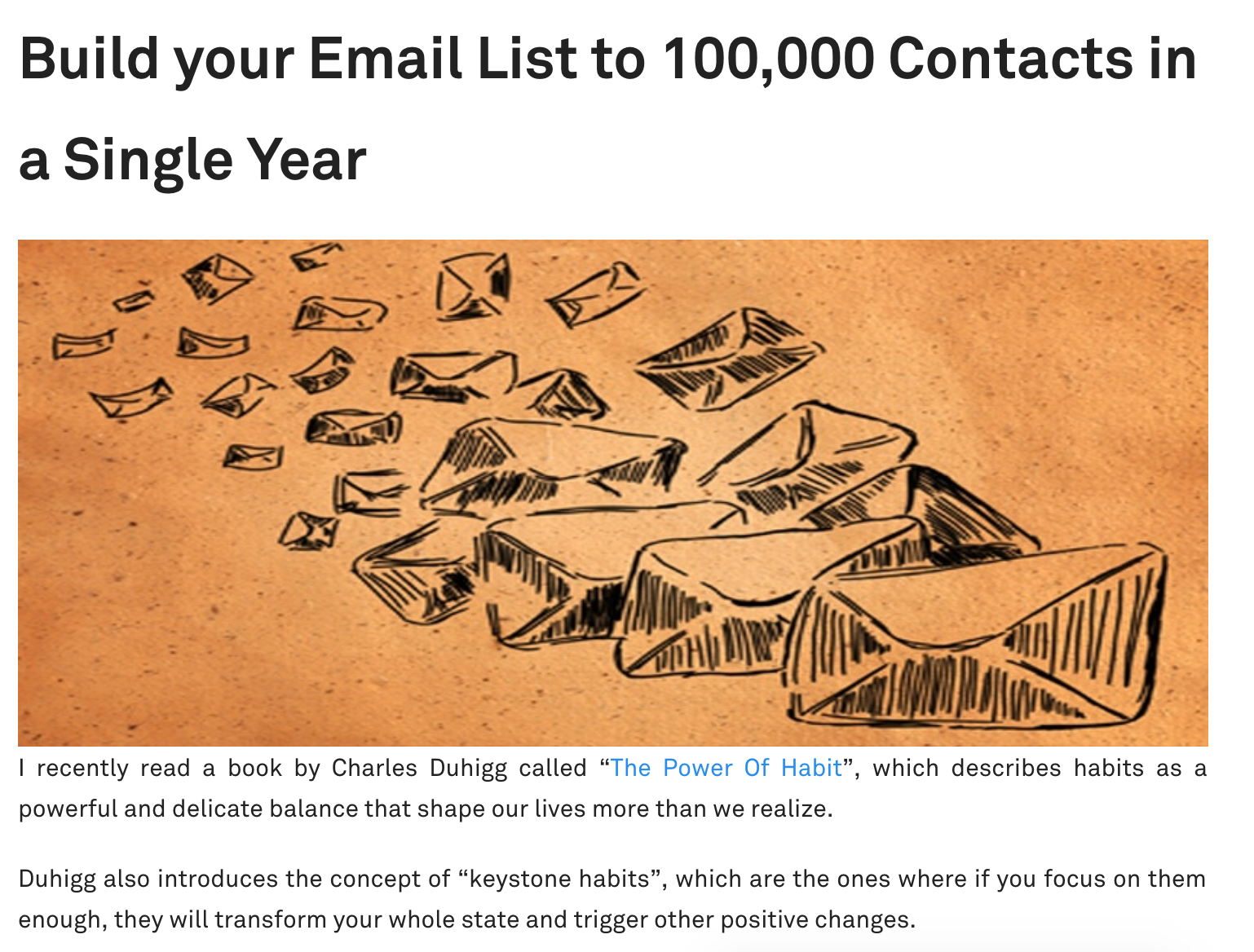
While building a 100,000 person list in under a year was something really aspirational for our market and even though we had never done it, we believed we could.
Our idea was that we would help them set up a funnel using the power of quizzes to capture leads very inexpensively from Facebook. Being those leads were so cheap, it wouldn’t take many sales to recoup what they spent and they could reinvest that money back into their Facebook ads to grow their list faster.
For your angle, it doesn’t need to be around email list size. For example, a naturopathic clinic probably doesn’t care about building their email list so your angle for them could be, “I’m going to help a clinic add 250 patients this year.” Or something like “I’m going to help a blogger generate an additional $50,000/month in sales by the end of the year.”
Whatever you come up with, tie it back into the niche that you choose. Making it a long-term goal that people were willing to invest in was helpful for us.
The next thing we did was promote our offer.
2. Mail Your Email List
The first thing we did was send this blog post out to our email list. I don’t remember how big our email list was at the time but it wasn’t huge.
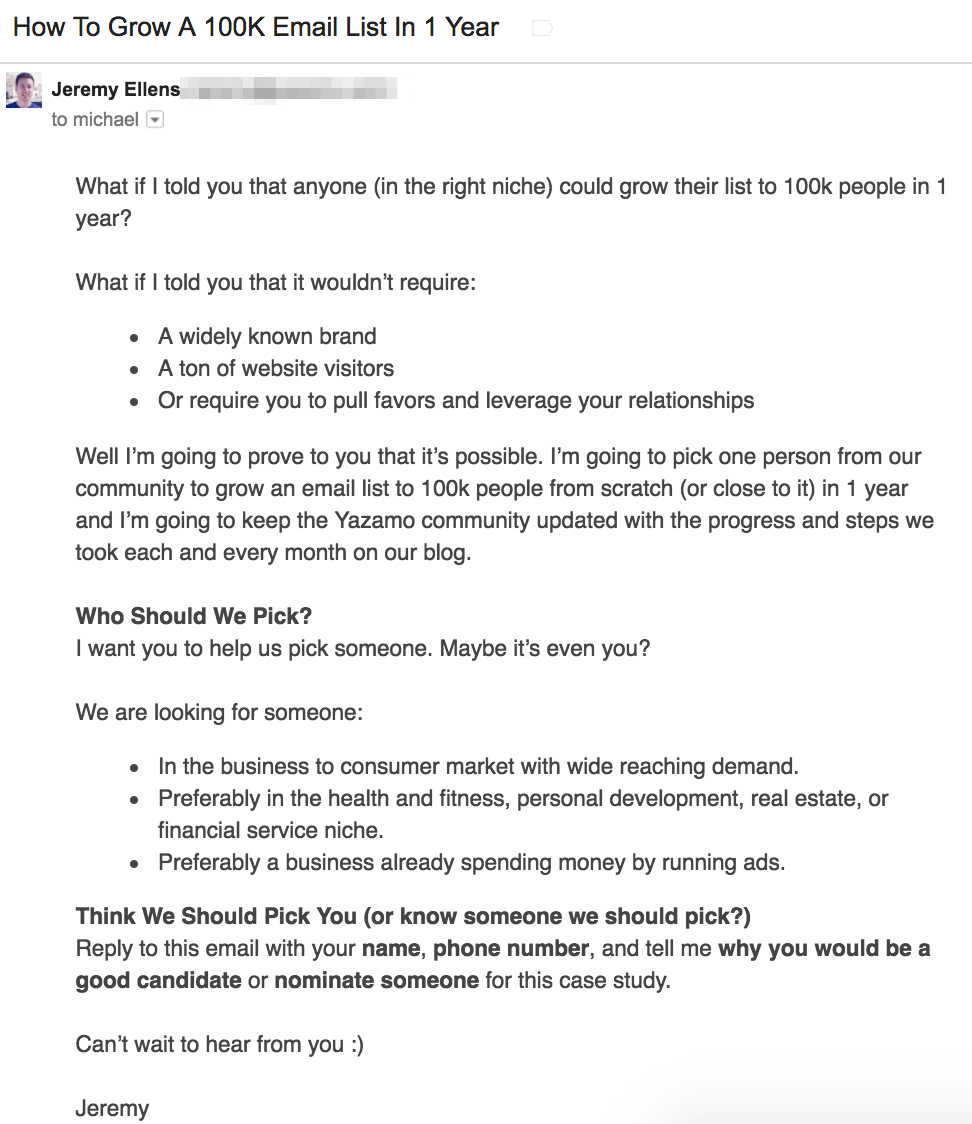
People went nuts and we got lots of responses like these:

And another:
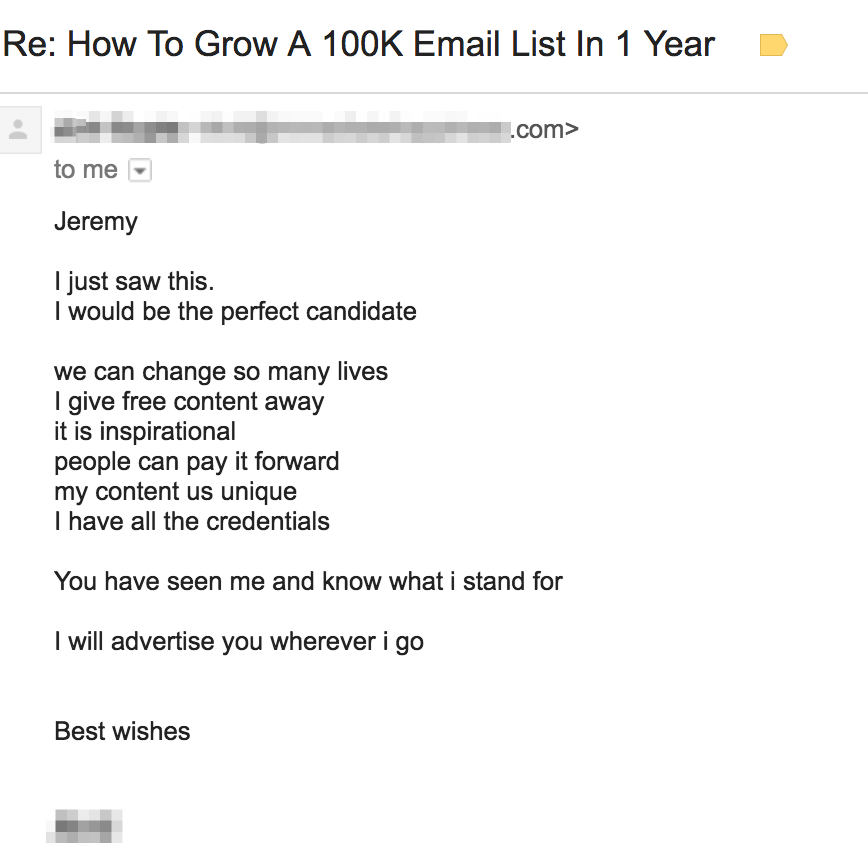
And another response:

And another one:

So first of all, obviously there was interest in the offer and we struck a chord.
Even though we didn’t state pricing, I think most people that responded assumed it would cost them something. Once we pitched them they still saw it as an incredible offer, because it was. We normally charged $5,000 for a setup and at least $3,500/month for ongoing management work.
We didn’t want to put all of our eggs in one basket being we were doing this for a client and not ourselves so we decided to sign up more than one person for the case study. We also decided that we wanted to prove we could get repeatable results over and over.
The business from the last response alone went on to spend over $19,000 with us so far since replying to this email. How about that for demonstrating the power of an email list? 🙂
Once we started seeing the outpouring of responses, we believed we could make our lower priced, $1,000/month offer work at scale.
When we felt like we tapped out our email list, we got creative with our lead generation…
3. Referrals
Here’s what we did to start generating referrals.
1. Message Existing and Former Clients
The first people we turned to were existing clients.
Being these were warm referrals, I thought I could put more detail into the email explaining pricing and how it would work so that it didn’t sound too good to be true.
I made sure to set a price comparison so people knew they would get a good deal and added urgency and scarcity to the email as well to get people to act quickly.
I also was very specific about what I was looking for, making the referral easy for people to think of someone if they matched the criteria.
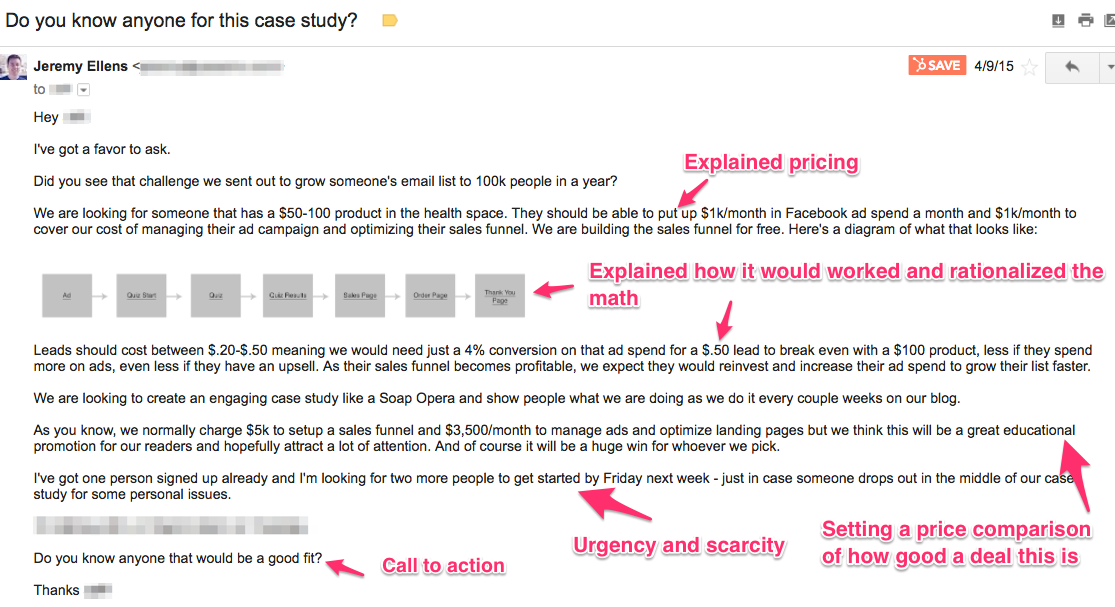
I sent this out to all of our existing or former clients that I thought it would be relevant to.
Here’s an example of one client that forward the email to 9 people:

He obviously did some amazing things here to set up a great referral including putting everyone on the same email to increase urgency and state that this will go quick, reinforcing the price comparison by sharing what he pays us, his personal endorsement, and opening up the idea of more people hopping on.
And it worked like gangbusters!
Here was one response from that referral who was willing to do make time on a weekend for a sales call:

And another one:

Some didn’t respond right away so I just sent them a follow-up message and got responses like this:

One person I jumped on a call with from this email was late to the party. I used the positioning that we had filled the spots I was looking for, which was true, but I was open to talking to her and see if we would make an exception.
I want to be clear this wasn’t just a BS tactic. At the time, it was like we were gunslinging in the wild west. We legitimately weren’t sure how many clients we should sign up at and it was a little scary offering our prices at $1,000/month when we were used to charging $3,500 – $10,000 per month. In hindsight, this pricing strategy worked out well for us.
So I jumped on a phone call with her and this referral literally said she would have my baby if we would make an exception and take her on as a client.
Think about that for a second. Granted it was a joke, but think about how powerful the positioning was that I created to put her in that state of desire where she was selling herself to me as a client. Or the positioning I created that had some of the respondents ready to call me back as soon as they were on break at their conference during the weekend.
This is the same positioning you can create by following our guide.
Fast forward a couple weeks after I got in touch with everyone that was referred from that single email and I ended up closing 6 out of the 9 people on that email.
What’s even crazier is that I created enough intrigue that everyone wanted to signup. Two were interested but couldn’t afford our case study pricing and one person that was interested wasn’t a great fit for our model.
This single email ended up resulting in $90,268 of revenue to date from those clients or an average of $15,000 a person. And this doesn’t include the many referrals we got based on our clients from that email.
2. Message Other Relationships
After I finished emailing clients, I moved onto friends or people that I knew in my industry. It didn’t matter how little I knew them, I started firing off emails and Facebook messages.
Here’s a Facebook messenger example of someone I met at a conference a year prior and didn’t know very well:
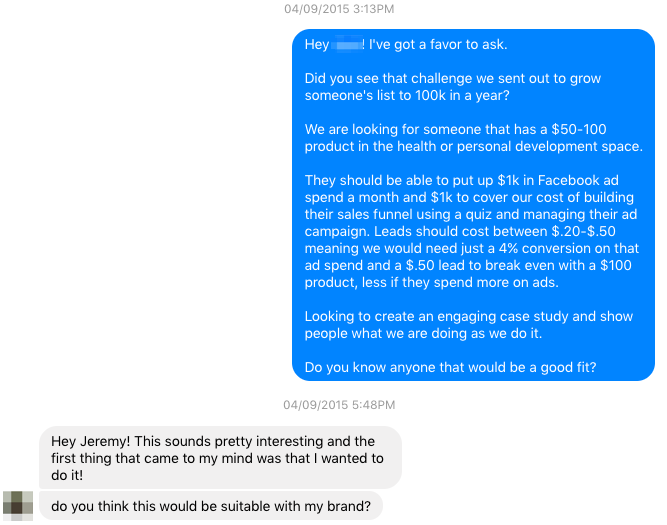
After a quick phone call, they signed up.
Unsurprisingly, if your referral request sounds enticing many people will self-select into it.
Here’s another Facebook message I sent to a guy I met on Bourbon Street at a conference in New Orleans. We didn’t know each other very well but people like to help if you’ve got a great offer, you’ve identified your niche and have a very specific intro you are looking for, making it easy for them to refer you.
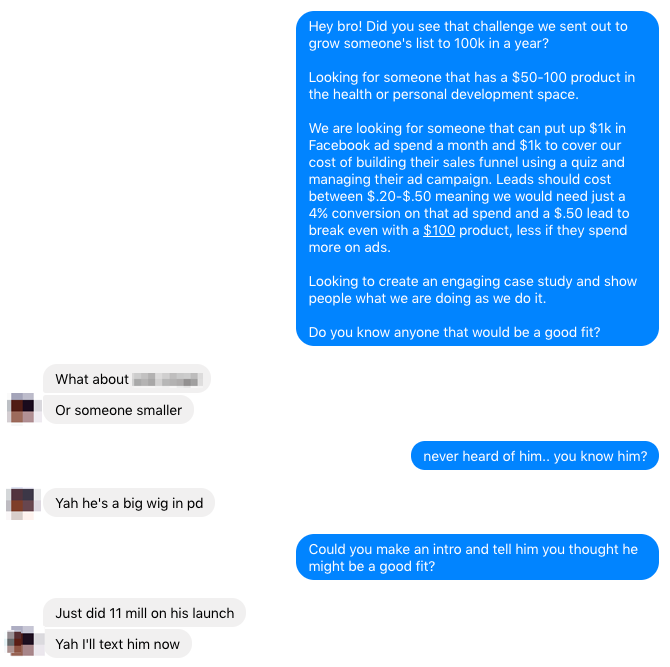
And we signed up his referral.
I continued to send this message to literally everyone I could think of. I went through email, my friends on Facebook, my phone contacts, etc.
I could go on and on and share a ton of examples of people that we closed, but I think you get the point.
What I’m trying to demonstrate here is after you pick a niche and make a compelling offer with the right angle and positioning, getting sales isn’t as difficult as you think.
You don’t need pre-existing case studies. You don’t need to have very deep relationships with people to ask them for referrals. You don’t need a website. You don’t need business cards.
You just need to articulate what you have to offer, who you want to be connected with and why that will make your referrer look good by connecting you.
Get over your fear of rejection, and go out and make things happen!
4. Cold Outreach
After we felt we exhausted all outlets for referrals, we needed to find a scalable opportunity to generate leads and sales.
We stumbled into cold outreach because we didn’t have a lot of money at the time for advertisement and we started to see a pattern with our referral clients.
Many of them were participating in online summits. Online Summits are something where a host will interview 25+ experts around a specific topic over a period of time. In our case, these topics could be things like brain health, cancer, ADHD, etc.
Most of these experts had online businesses, were interested in growing their email list and fit into our target market. Here’s an example of what one of these summits looked like:

So we started researching different online summits that were relevant to our target market and then creating a list of leads that we could reach out to. We decided to try reaching out to people directly through Facebook messenger at the time so we needed to find their personal profiles and add it to this list.
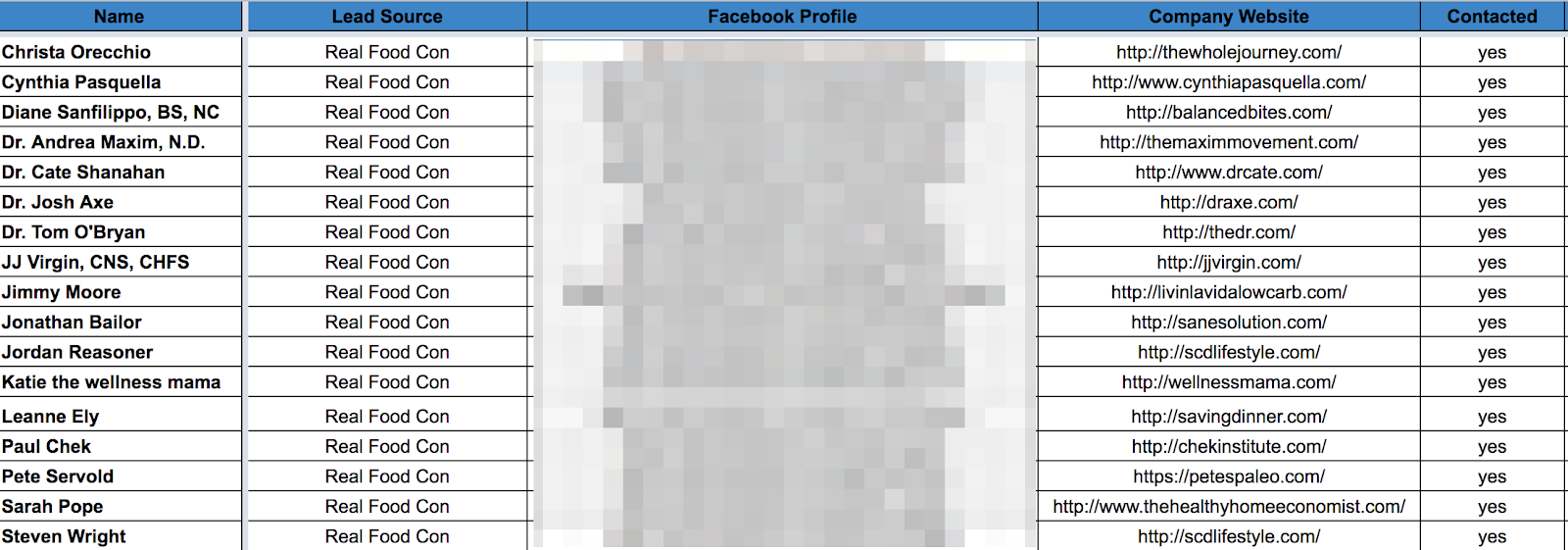
The next thing we did was create a script to use for outreach. Here’s a great example of the three step script from a client that we closed:
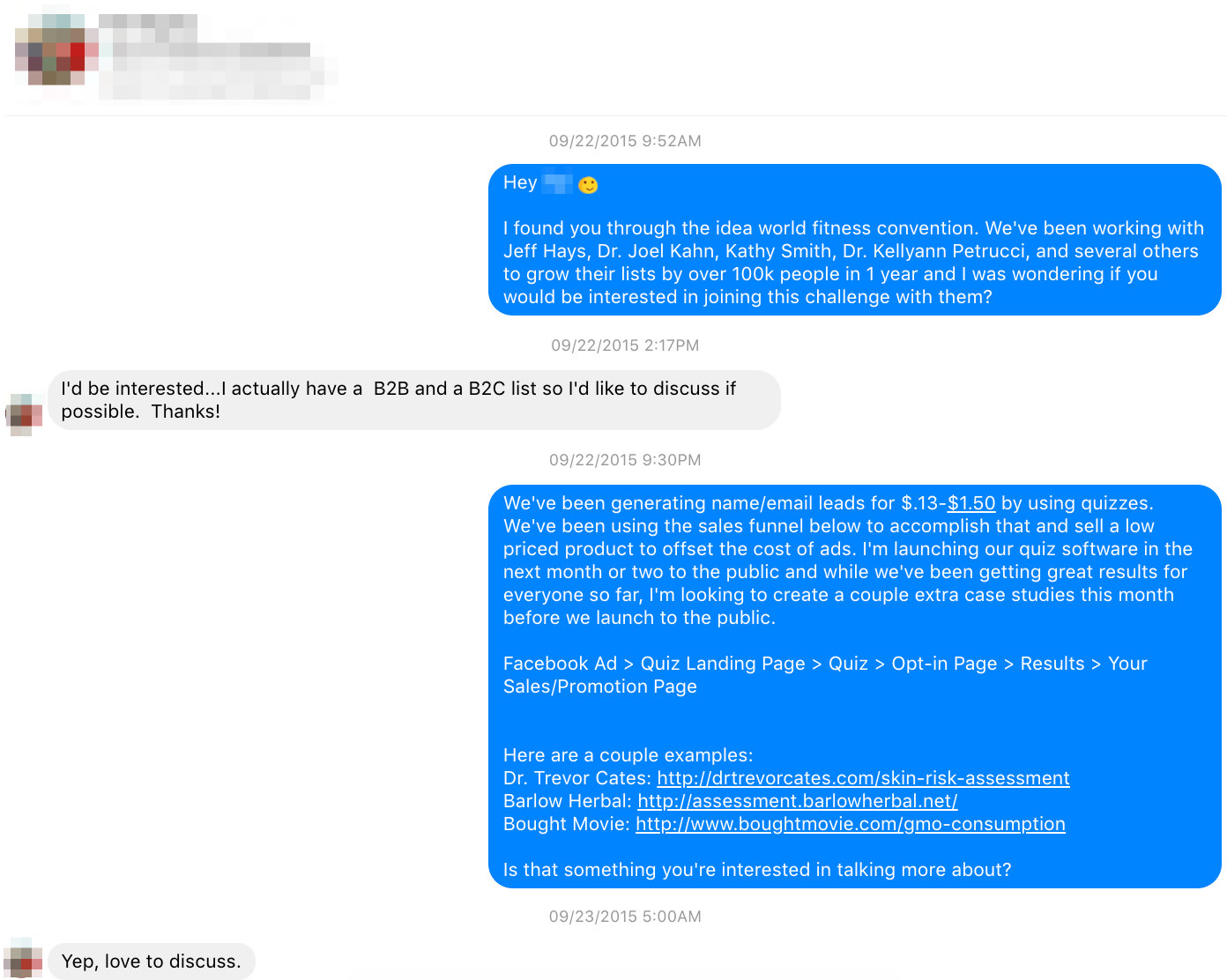
Script 1
Here’s what I did with the copy in the first script:
- I told them how I found them because most people will want to know.
- I name dropped some people that they might know or people they were potentially mutual friends with on Facebook to create trust and credibility.
- I briefly told them what we were doing and how it would help them without coming off salesy i.e. a challenge to grow 100k emails in 1 year.
- I asked if they were interested.
What you see is that I’m just trying to get a small commitment of interest. I found if I dumped the entire script on them at once, it was less effective.
Script 2
Once they said yes I sent the next script and here’s what I did with that copy:
- I give some explanation and logic behind what we’re doing i.e. we’re going to get you cheap leads and then you will sell them a product to offset the ad costs and scale your lead generation.
- I plant the seed that this will be a good deal but not too good to be true i.e. we’re trying to generate case studies.
- I briefly explain the funnel so they understand.
- I name drop and link to some case studies that we built from our referrals so I can build further credibility.
- Ask again for interest
Script 3
After they said they were interested, the third script would say:
“I can go over all the details to see if you would be a good fit for this challenge on a call. Here’s a link to my calendar to schedule: (insert Calendly link).”
So once we had our list and a script to message people with, we just tracked the results in the spreadsheet above. A lot of time people would engage and then ghost and you would have to follow up to get them back into your sales funnel. Not a big deal, just keep track of it all so you don’t miss out.
Here’s another example of the script in action:
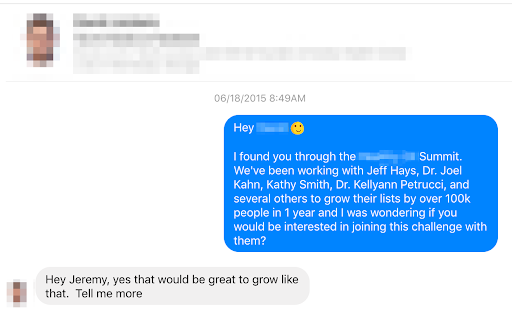
And another:
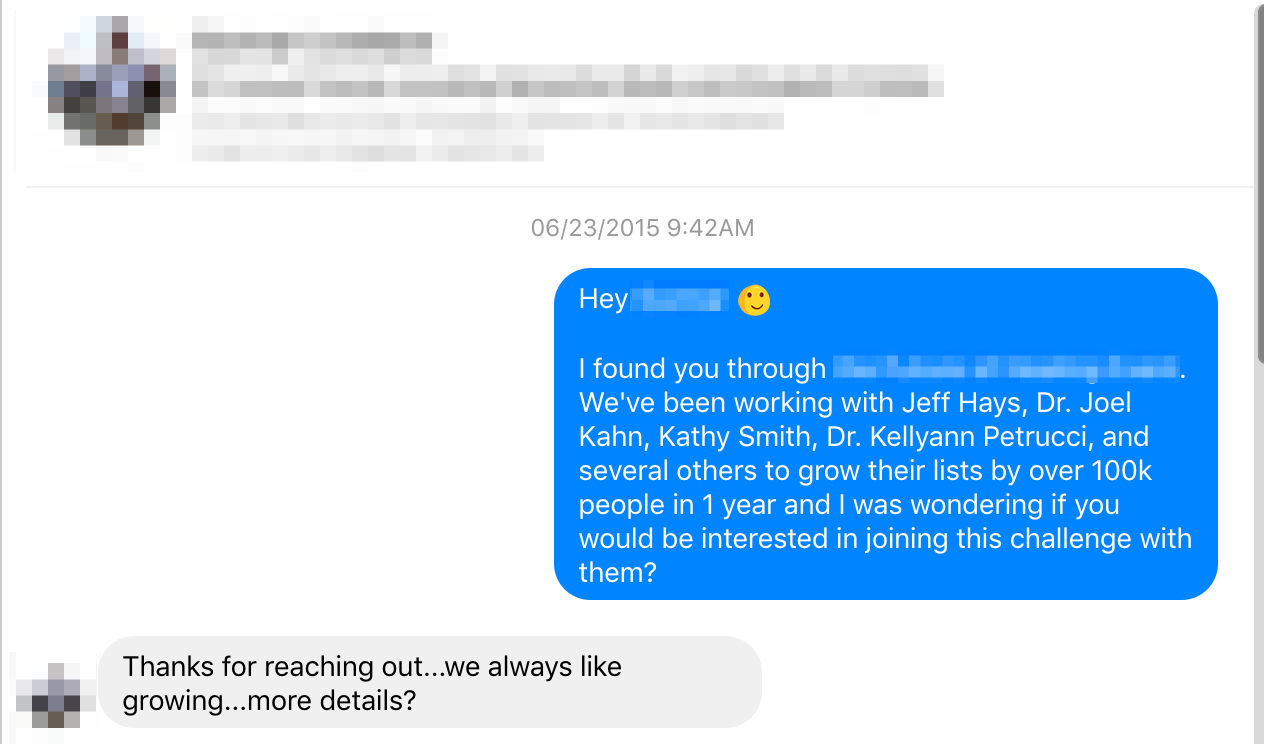
We even closed influencers like Dave Asprey from Bulletproof using scripts like this:
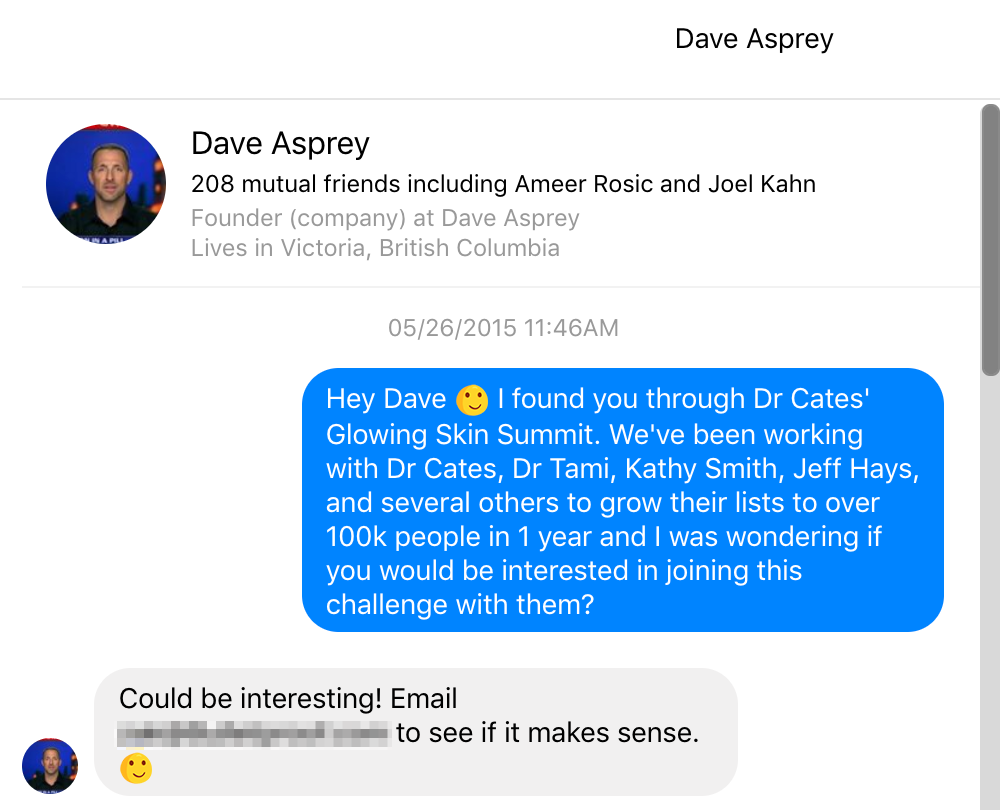
If they asked to email them, we would just send the second script via email format.
Scaling Your Outreach
Once I got this working, I hired a virtual assistant off Upwork for $3/hr in the Philippines and taught him my same process. I put him to work full time and he was able to research 250 people a week and send hundreds of messages.
Now instead of trying to create a list, send messages, follow up with leads to get them scheduled AND do sales calls, I just focused on closing leads.
I batched all my sales calls into two days a week so I could get in the zone and focus. Once I had the virtual assistant cranking, all I had to do was show up and he would have about 7 sales calls a day scheduled for me. Usually, I would get one or two no-shows a day but I was closing 2-3 new clients a week with this outreach process.

Outreach Summary
Cold outreach was financially very effective for us starting out and helped us get some major influencers on board. We built a list of about 4,000 people by hand that we did outreach to. The downside was after we messaged them, we couldn’t put them on an email list to follow up with as we didn’t want to worry about spam complaints.
Sometimes we got angry messages from cold outreach but we also got a lot of people that were really glad we reached out to them.
If you choose to do cold outreach, I wouldn’t suggest using Facebook messenger because they changed their algorithm to prevent messaging people you don’t know and it stopped working for us.
That being said, here are the fundamentals of how to make cold outreach work for your business:
1. Build your List
Think about where your target market hangs out.
For example, if you are targeting local gyms, you could do Google searches in different cities to find websites and come up with their contact information. You can also look for Facebook or LinkedIn groups for gym owners. Additionally, you could search Yelp for gyms.
There are a lot of strategies you can use to build a list but again, make sure you keep your target market focused so that you can go deep with them and retain your clients for a long time.
2. Develop a Creative Contact Method
You will need to test different sources to see where your target market responds best.
While we mainly used Facebook messenger, you can try email, phone calls, LinkedIn, Twitter, Instagram messages, etc.
Get creative! Who knew Facebook message would work so well for us in doing outreach?
3. Test Your Messaging and Track Results
Track your results in a spreadsheet and test what works based on open rates, response rates, calls scheduled, and close rate. Mixmax is a great tool to create templates and track results if you use email. Right Inbox for Gmail is another great tool to use for creating templates.
4. Scale with a Virtual Assistant
Once you figure out how to build a list, find a medium and script that gets responses and people scheduling calls, it’s probably time to hire a virtual assistant to scale this process for you so you can just focus on closing people.
5. Batch Sales Days
Once you are ready to scale, I highly recommend batching sales days. As a small agency, focusing on a predictable sales model is one of the most important things you can do. I found that setting aside uninterrupted days where I was able to get into the sales mindset was crucial.
5. Facebook Advertising
The next thing we started doing after cold outreach was run Facebook ads.
The huge benefit here compared to cold outreach was we were capturing leads and building our email list regardless of whether people bought right away.
Your goal with selling high ticket services from Facebook ads should be to recoup your money back and be profitable immediately but long term your email list will continue to pay you money.
Even if we just considered closing a single sale and ONLY getting $1,000 from them, if we were paying $10/lead, we could capture 100 leads and only have to close one person to make our money back. And that’s a huge assumption that this client isn’t staying on for months or years like our best clients. That also assumes you would only be able to close 1/100 leads.
We used multiple Facebook lead generation strategies that worked well and generated leads between $7.50 – $10/lead.
Some of our Facebook targeting strategies included using lookalike audiences of our customers and our leads, retargeting our website traffic, and advertising case studies towards specific interests.
One strategy we used that worked well was cold contacting or getting an intro to influencers like Neil Patel and Lewis Howes with big social followings. We created a quiz for them for free in exchange for a case study if it worked for them.
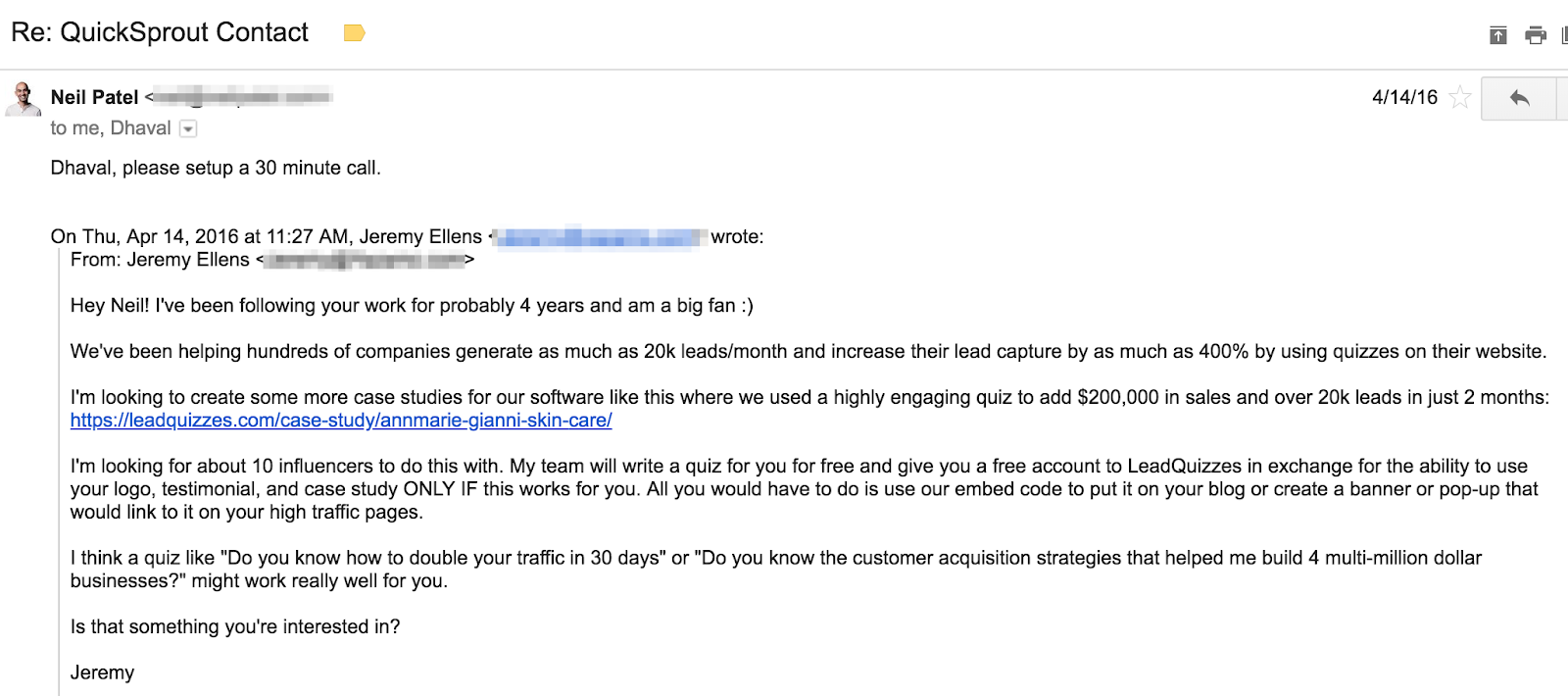
It did work for both of them and so once we got case studies and their permission, we ran ads towards their followers on Facebook.
The ad creative that worked best for us was either a video testimonial or an ungated 30+ minute full case study video with the call to action being to sign up for our lead magnet.
We primarily leaned on two lead magnets.
1. Quiz Lead Magnet
The first looked like this:
Facebook Ad > Quiz > Optin > Calendly Link on the Results Page
Here’s an example using Neil’s video testimonial:

This ad led to a quiz that would lead them through a series of questions like how much website traffic do they have, how much do they spend on ads, etc. so we can help them determine if quizzes would be successful for them:

Before we gave them their results, we asked for their name, email, and phone number.
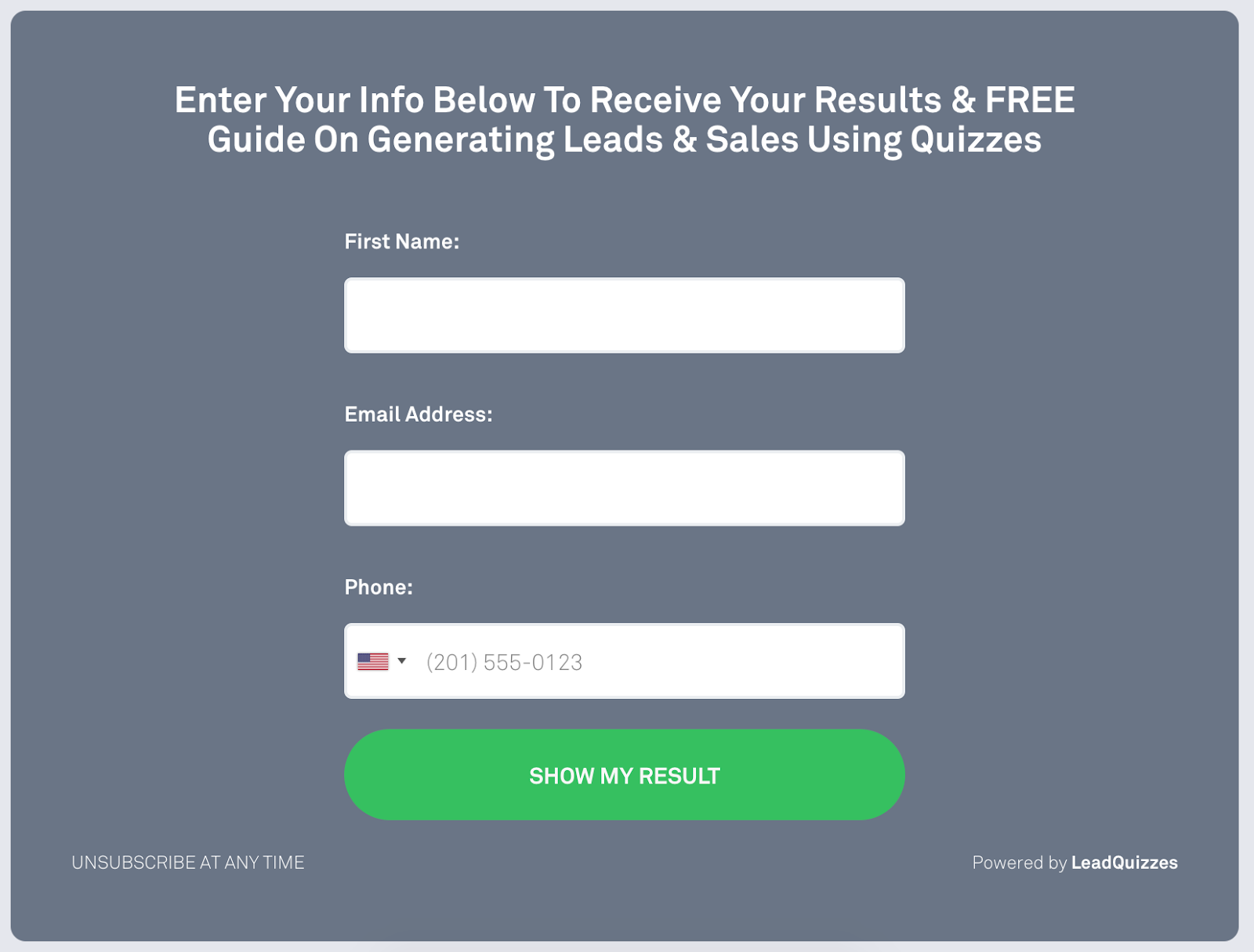
At the end of the quiz, we gave them their results and led them to a Calendly page to schedule a call with us about using quizzes in their business.
2. Video Training Lead Magnet
The second lead magnet looked like this:
Facebook Ad > Optin Page > Video Training > Calendly Link
On this ad we leveraged the stats from our Annmarie and Bourbon and Boots case study.

They would be taken to an optin page where we captured their name, email, and phone number.
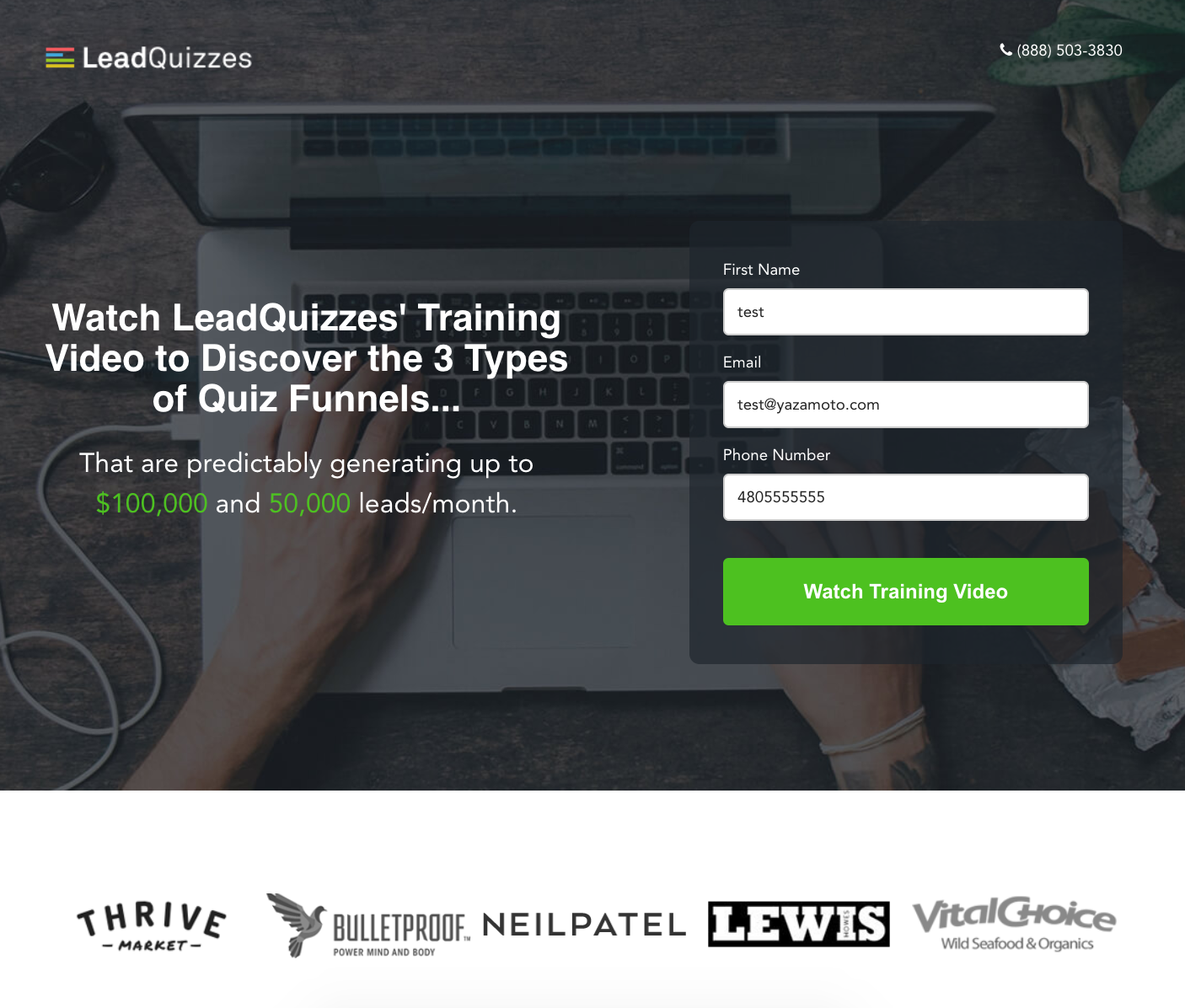
This would take them to a video where they would be educated for an hour on how to use quizzes in their business and to schedule a call using Calendly.
We talked with the people that scheduled but we also needed to call our leads to make our campaigns profitable, hence the phone number collection on the optin pages.
At first, we were hesitant to ask for phone number because we thought it would be a lot more expensive but found that it wasn’t. Sure we got some bad phone numbers but we got a lot of accurate phone numbers too.
Figuring out Facebook ads was a huge breakthrough in the scalability of our business and long-term ability to close clients outside of referrals.
We’ll talk more about how we contacted these leads with a dialer in a minute.
6. Website Leads
We also choose to take advantage of the website traffic we had and capture leads there. If you want to learn our SEO strategy, this is a great article explaining what we did.
Ultimately, the people that were coming to our website converted higher than any other channel we used. We used the same lead capture strategies as our Facebook campaign, a quiz and video training on our website and lead them to a Calendly page. After we captured their info we called them if they didn’t schedule a call with us.
We put call to actions to both of these lead magnets on our homepage, on our blog, on our website as a popup, and by using a Hello Bar. You should test adding these lead captures pretty much everywhere on your website.
Section 3: Dial and Email Your Leads
Before we jump into closing the leads you’re getting, I want to talk about how to get more of the leads that aren’t scheduling with you on sales calls.
While not every lead is going to schedule calls with you, that doesn’t mean they aren’t qualified to buy from you. We made this assumption for too long until our coach corrected us.
What we did was we put the leads that hadn’t scheduled with us through a series of 4 emails and 7 phone calls over a 9 day period.
Phone Calls
We used a dialer called Dialsource with Salesforce to quickly call leads. You can use cheaper alternatives like Base if you don’t use Salesforce.
With a dialer, you can create lists of people to call based on different criteria like:
- Most recent leads
- Highest lead score (using data like emails opened, quiz answers like company revenue, website traffic, etc.)
- Or just dial everyone
In general, the faster you get back to someone the better. Five minutes or less is ideal so you can help them while they are most engaged and before they’ve researched competitive solutions.
The huge advantage of a dialer is that once you create a list of people you want to call, you click start and it dials the lead. Once it connects if they don’t pick up you can click a button to leave a pre-recorded voicemail, it automatically logs the call, and then immediately dials the next lead.
If they do pick up, you just go directly into the sales script, which we’ll get to in the next section.
A dialer takes a lot of the manual work out of the process and removes the second-guessing around “Should I really call this lead?” which slows down the sales process a lot.
Email Sequences
Below are the five emails our salespeople would personally send through a sequence in Mixmax to try and generate replies or scheduled calls in collaboration with the phone calls.
Email 1:
Subject: Predictably Control Growth
Hey Contact First Name!
I noticed that you started our LeadQuizzes Blueprint Webinar. Did you get a chance to watch it yet? My name is John and I’m your Success Coach over here! My job is to help you come up with a plan to dial in your marketing efforts, and start increasing your sales.
We help businesses create a predictable and scalable source of leads and sales using quizzes! We’ve already helped hundreds of customers just like you see a 400%-500% increase in lead capture.
I can share some specific strategies on how to make quizzes effective for your business on a short call after I understand your marketing funnel. Select a time using the link below that will work for both of our schedules 🙂
<Calendar Link>
Talk soon!
John Smith
LeadQuizzes Success Coach
Phone number
Email 2:
Subject: Hello from the other side
Hi Contact First Name,
If you’re ready to amp up your sales and lead generation, I’d love to help you get started! Curious to learn more about how online quizzes push our psychological buttons, resulting in thousands of leads for your business? Check out this article detailing quiz psychology and what makes them so dang effective >>
Are you available for a quick call to see how we could partner with you? Just let me know what works best for you. Here’s the link to set up a call:
<Calendar Link>
I look forward to hearing from you!
Cheers,
John Smith
LeadQuizzes Success Coach
Phone number
Email 3:
Subject: Thought this might be helpful
Hey Contact First Name,
Your interest in generating more leads and sales got me thinking.
Our co-founder, Jeremy Ellens, wrote an article on the different stages every business will go through as it grows, and the keys to success that pertain to stage. I thought that you would find it beneficial as you progress.
Here’s the link to read it. The 5 Stages Every Startup Must Go Through
Hope you find it helpful,
John Smith
LeadQuizzes Success Coach
Phone number
Ps,
I’m hoping to talk to you about your current marketing and advertising strategies, but also outline a thoughtful plan as to how quizzes can help your business. You can use the link below to pick a time/date that works for your busy schedule:
<Calendar Link>
Email 4:
Subject: Permission to close?
Contact First Name,
I’m writing to follow up on my email. We are in the process of closing files for the month.
Typically when I haven’t heard back from someone it means they are either really busy or aren’t interested. If you aren’t interested, do I have your permission to close your file?
If you are still interested, what do you recommend as a next step?
Thanks for your help.
John Smith
LeadQuizzes Success Coach
Phone number
Alright now that we’ve optimized the number of leads getting on sales calls with us, we can move onto the sales script we used to close leads.
Section 4: The Sales Script to Close Your Leads
The first thing I want to tell you is that sales is a learned skill.
I was terrible at closing sales when I first got started with Yazamo.
Here’s the good news:
Even if you are currently terrible at sales, if you implement what we taught you in the first three sections, you should close more sales.
Before we even jump into the sales script, you already know what you are selling, you know your pricing, you aren’t going to go back and forth with proposals, and you’ve positioned yourself really well to close the sale.
Becoming great at sales will take practice but you can do it. The first salesperson I hired who had ZERO sales experience sold over $16,000 of new business in his first month. That’s collected revenue, not projections of what those customers went on to spend month after month. He just put in a lot of hard work and followed the training process and sales script you are reading right now.
But I know you want the sales script 🙂 So let’s jump into it.
Here’s a brief overview of the script:
- Intro
- Sales Questions
- Presentation
- Pricing
- Objection Handling
- Close
1. Intro
The intro will change slightly depending on what lead source you are using but you should be able to easily adjust it.
Hey, fname! This is _______ from LeadQuizzes, how’s it going today?
I noticed you were checking out our [3 types of quiz funnel training]. Did you get a chance to watch it yet?
No -> No problem… so we’ve been helping thousands of business generate more leads and sales using quizzes. (fname) I would love to ask you a few things about your business so I can share some tips on how we could make this work for you. Does that sound good?
Yes -> Great, what did you think about it? Awesome, well I’m sure you have some questions about it, but before I jump into that, I would love to ask you about your business so I can share some tips on how we could make this work for you. Does that sound good?
Most people in sales want to find some common ground to connect on things like weather, location, etc. My philosophy in sales is that you are not selling a $1M contract here. The person you are calling is busy and wants to know how you can help them.
I try to get right to the point so I can help them or get off the call. You should be able to complete the entire call in 30 – 45 minutes and as your calendar starts getting booked you want to crank through them and pay attention to how much time you spend on each section of the sales script.
2. Sales Questions
- How did you hear about us?
- I have your information pulled up in front of me but could you tell me a little bit more about your business?
- What is the product or service you’re selling?
- How are you getting leads online right now? (Dissect the Funnel)
- Are you spending anything on Facebook Ads?
- How many leads are you getting?
- How many of those leads buy?
- What are your goals with LeadQuizzes?
- Ok, I feel like I have a pretty good idea of where you are at now but before I jump into explaining our process, is there anything else you want to share?
Through these questions, I’m trying to figure out how their existing funnel is working and if they would be qualified to work with us.
If I know things like their cost per lead and conversions, I can use that information to compare to our case studies later during our presentation or objection handling.
With the goals, I’m able to see if their goals may align with the case study challenge angle we created earlier. Finally, I find out how they heard about us so we can measure ROI of our marketing if we don’t already know.
3. Presentation
“So to give you a little history… We created our first quiz about 2 years ago with a hormone doctor named Dr Tami. She had a successful local practice but she wanted to have…
- A bigger impact on women all over the world
- Generate more online sales
- Become a national bestseller
So we built a quiz, advertised it on Facebook and after we dialed things in, we were blown away by the results…
- We generated just under 35,000 leads in 6 months at $.19 per lead (normally $1-$3/lead if training videos, ebook, webinar, etc.)
- Dr Tami went on to have a much bigger impact, made a lot more sales online, and became a national bestseller.
Pretty awesome right?
Well, we are actually doing a case study challenge right now to help 3 more health professionals grow their email list by 100,000 people in a year. We’re going to document that process on our blog as we go to attract more customers.
Here’s how we’re going to be doing it:
We use a quiz and Facebook ads to capture leads. After the quiz we sell a low priced product to offset the cost of ads, which allows us to scale the Facebook ads and grow an email list quickly.
Does that make sense?
So all of that being said, do you think you would be a good fit for our case study challenge to grow your email list by 100k people this year? (have them explain why)
You will need to tailor this presentation towards your industry, your challenge, and your story.
If this is brand new for you than you can be honest and leverage our case studies by saying something like “We came across a case study of a real estate agent named Devi Cooper who was able to generate a $10,000 commission on $50 in Facebook ad spend. I’ve been doing digital marketing as an agency for the past 3 years and I really want to specialize on lead generation with quizzes and focus on the real estate industry. We are going to use the same method as her and are looking to build case studies to attract more clients.”
This section you will be doing the most talking out of the whole script so stop and check in and keep them engaged throughout. Get them to tell you they are a good fit at the end.
Finally, ask the question if they think they would be a good fit and why to get them to self-select into your case study. You want them to sell you on why they would be a good client. Most will if you’re talking with someone qualified.
4. Pricing
So normally we charge $5,000 to setup a marketing campaign and $3,500/month to manage the ads and optimize the funnel.
Being I’m going to leverage our work together as a case study to attract more clients, for the next 3 case studies, I’m going to offer an amazing deal and the pricing breaks out in two steps:
- To manage your ad campaigns and optimize your quiz funnel, we ask that you invest $2,000/month. $1,000/month will go to our management of your ads, optimization of your quiz funnel, and coaching on the sales. $1,000/month will go to your Facebook ads.
- I’ll waive the $5,000 setup fee to write your quiz, get it set up on our software, integrate it with your CRM and make sure everything works.
Would you like to be one of our 3 case studies?
(SHUT UP! WAIT FOR THEM TO RESPOND)
If they agree, then skip to the close section.
If they say no or have questions, then move on to the objection handling section.
In this section, it’s really important for you to price position what a deal they are getting and the scarcity involved with the limited case studies you are going to take on.
If you nail this and you’re talking to someone this will be helpful to, you have a great chance of getting a yes right off the bat. That being said, don’t worry if they say no or if they have questions. You should expect that answer and be ready to solve their objections or questions and get them to close on this first phone call.
5. Objection Handling
One of your greatest strengths in closing the sale with the positioning we’ve talked about is using the urgency card. Remind them how great a deal it is and tell them you believe these case studies spots will be filled up by X date based on the calls you have scheduled, the people you’re already talking to, etc.
With such a great offer and positioning, a lot of time your objections will really just be clarifying questions.
Clarifying Questions
You will probably have multiple clarifying questions around what the funnel consists of, how much work they need to do, etc. Answer those questions and then go back to your closing questions (see below).
One specific clarifying questions I want to point out is on the rebilling process.
This is what I recommend you say about billing only if they ask so that they don’t drag their feet on rebilling. Otherwise just put it in the contract and explain it to them after you get their card: “You need to pay your first $1,000 ad management fee up front. The setup should take less than 14 days and you won’t be rebilled your second monthly management fee until 45 days from now.”
However, beyond clarifying questions, you should be prepared with responses for the most common objections and you should practice these responses. Here are some of the top ones we’ve encountered:
Price Objection
I’ve closed tons of leads where at first they think something is too expensive and then they change their mind. Let’s look at some example responses:
“$2,000/month is too expensive for me”
With a response like this, I would try to do the math for them based on the questions you asked so logically they can back up their investment.
Example response: “Ok (fname), let’s just run through the numbers you gave me. You said that you earn $1,000 per customer. That means you only need to close two clients to pay back your investment with me. Furthermore, based on the lead costs you shared with me, I believe we can cut those in half meaning we would double the number of leads you generate a month and you would only need to close X% to pay back your investment. And on top of that… you’re building a list that you can continue to market to. Doesn’t that sound like a good investment to you?”
Bad Timing/Not a Priority
The biggest power you have here is to hit on the fact that you are offering an amazing deal and it is limited to the next X case studies.
Example response: “Ok (fname), let me ask you a question. Do you like the idea of achieving X by using quizzes? Does it make sense to you? Awesome, well if you want to try this out, now is the perfect time. As I’ve stated, I have X spots left that will probably be filled by X date based on the calls I have scheduled. After then, the prices will increase to X. Is saving $X money important to you? Ok, so what do you say, want to give this a shot?”
I Want to do this Myself
Remind them of the deal they are getting and benefits by working with someone like you who specializes in this.
Example response: “Ok (fname), well let me ask you a question. If you had the ability to learn from an advertising budget X times larger than what you are going to spend and have the repetition of doing this with X clients, do you think that would help you see results faster and save wasted time and money with experimenting? Exactly. And that’s one of the greatest advantages in working with us… we get a lot more practice and feedback because we work with X amount of clients on this exact process. On top of that, I’m practically giving this away compared to my regular pricing.”
Will This Work for Me
This objection will get easier the more experience you have. If you have experience, I would lean on the case studies you’ve been able to generate and talk about how it has worked for other similar clients.
If you don’t have experience, you can lean on our case studies. If we don’t have a relevant case study you can talk about the advantages of quizzes and how they increase lead capture because they are fun, they give personalized feedback, and they work great on Facebook.
I would follow the Feel, Felt, Found model for this and then bring them back to the close.
For example, “I understand you feel apprehensive about trying something that’s different than what you normally do to get leads, that’s exactly how my client X felt when we started working with them, but what they found was by making a decision and committing to this strategy, they were able to see X results. What do you say, do you want to give that a shot?”
Try to Delay
Often times you will get a lot of excuses that to the inexperienced salesperson will sound positive. Don’t take them at face value. Understand you have not done your job of selling them yet. Try to figure out what is really holding them back and how can you close them on the same phone call.
“I need to talk to my partner”
Example response: “Once you talk with them, if they are on board, are you ready to move forward today? No? Ok, so what’s really holding you back?”
“Send me the contract to review/send me an email summary”
Example response: “Sure I can definitely send that to you but it will be exactly as I described… (repeat pricing and terms). Were there some specific questions you had about it?”
If they really stress wanting to review the contract, offer to send it and review on the call. Chances are it’s a stall or way to avoid making a decision.
Example response if they keep making excuses: “Listen (fname), I can take a no. If there’s something you are still hesitant about, let me know so I can help address it.”
If you still can’t get them here, reiterate scarcity of the offer.
Example response: “I want to remind you that these 3 case study spots will probably not last more than X days based on the calls I have scheduled. If you are interested in doing this, now is the time. Do you want to move forward?”
After you’ve gone through some objection handling and they are still trying to delay and be ambiguous about their decision, you want to be more assertive. If you have to schedule a second call, your chances of closing them will go way down. You have them in a higher emotional state right now so push for the close.
“I don’t have a credit card on me”
Example response: “No problem, I’ll wait on the line while you grab it.”
This can often be a response from the least confrontational leads you will talk to who are scared to say no. If they really want to sign up, offer to wait on the phone while they go grab it. Do not hang up.
Bonuses
If they are close to closing but still not there, you can add in some bonuses that will really help push them over the edge. Bonuses that have worked well for us in the past are things like autoresponder swipe copy or offering to upload those emails to their CRM for them. It doesn’t take you much time or effort but for a client that maybe isn’t as familiar with this as you are, it could be a huge pain for them.
This sales script should be pretty solid for you to go out and close deals. If you are looking for some further help, here’s a great article we published around writing your sales script.
6. Close
I always make sure to charge a customer’s card before starting the kickoff process. Until you run their card, you do not have a sale no matter what they’ve told you and you don’t want to waste your team’s time.
Here are some lines you can use to ‘assume the sale’ or ask for their card in a non-threatening way:
“Getting started is easy, we just need to schedule your kickoff call. We have availability on Tuesday and Wednesday. Which day would be best for you?”
This is called an assumptive close and it can work when they are close to the edge.
I remember being closed with this tactic when I was ordering water bottle delivery service early on at Yazamo. I was going to think about it but the salesperson went for the assumptive close and took the mental strain of making a decision out of my hands. I knew what was happening but I was actually thankful he made the decision easy and I still use their service till this day.
Once you confirm a time that works, grab their credit card.
“Ok great, what card would you like to use?”
Personally, I don’t care if they use an Amex, Mastercard, Visa, etc. but this is an easy way to get them to start the payment process vs. saying something like “what’s your credit card number” or “I need you to pay the $1,000 today”.
“Do you want to give it a shot?” or “Do you want to take one of the 3 case study spots?”
These are pretty soft closes that can be thrown in after any rebuttal. If you’re new to sales, many people struggle with the ask but you should be continually asking for the close throughout the call.
7. Follow Up Call
If you’ve gone through all your objection handling and they really need to wait or discuss with their partner, make sure to get a follow-up call scheduled and send out an email summary and calendar invite. While these second calls have a much lower probability of closing than on your first call, adding this to my sales process greatly increased the number of follow up sales I made.
Section 5: Measuring and Managing Your Salespeople
As we scaled our sales, I soon maxed out the amount of time I had to sell so we hired two salespeople to come in and help.
What this did was force me to really dial in our sales process and bringing in a salesperson where it was their full-time gig, allowed us to scale even further.
In my experience, a good salesperson should be able to close 2-3 managed clients a week. If you use our pricing, that’s $2,000 – $3,000/week.
1. Measuring Your Sales People
As they say, what gets measured gets improved. So here’s the spreadsheet I used to measure and track my salespeople:

1. Dialer Hours
We drilled back from the number of sales we wanted to make and found that 3.2 hours on the dialer would be enough time to generate the number of correct contacts we needed.
2. Dials
In 3.2 hours a day, a salesperson should be able to get through 80 dials leaving messages and logging activities as they go.
3. Emails
While the salesperson is dialing their leads, they should be enrolling them into email sequences and sending 80 emails a day.
4. Correct Contacts
Correct contacts were broken down into scheduled and those that were connected with on the dialer. There were always no shows so we liked to keep track and make sure the percentage of no-shows wasn’t having huge swings each week.
5. Managed Wins
We expected 3 closed managed sales a week per salesperson to reach $3,000 in weekly sales.
6. Close Rate
We assumed a 25% close rate was possible if our marketing was pulling in the right leads. If our salespeople weren’t closing at 25%, they knew they needed to either analyze their calls and get better at selling or get their activity numbers up on dials or emails so they had more correct contacts to talk to close.
7. Dollar Value
I would have them record only the dollar amount that they ran on the credit card. Remember though that these clients should last for months or years if you’ve set everything else up right and do a good job of managing their expectations coming in and providing them value.
2. Managing Your Sales People
Call Recordings
We used RingCentral to make our calls because we could automatically record all phone conversations and review them for training purposes.
These were extremely helpful to review 2-3 times a week and point out areas for improvement. For example, a salesperson could be spending way too much time in questioning and then not have any time for objection handling. A salesperson could miss a buying cue to close and instead, they just keep talking over the client. Maybe a salesperson is really struggling with an objection over and over again. These things can all be identified in call recordings, addressed, and practiced.
Daily Meetings
I found that a daily 30-minute meeting was always best to review call recordings or practice role-playing different sales scenarios. Like clockwork, whenever we did these meetings, sales would improve. When things were going good and my work got busy, I would often pull back on these meetings and sales got worse. My suggestion is to keep them going consistently.
Look at a professional NFL team. They spend 6 days practicing, lifting weights, and watching game film to prepare for their game day. Make sure you are spending enough time training your sales team and not expecting them to just learn on game day (sales calls).
Blocking Time
Just like I blocked time for sales days, I had our salespeople schedule blocks of time in their day for dialing and for scheduled calls. Dialing takes dedication and you need to get uninterrupted time to get in the zone.
Competition
Let me share an analogy with you.
In the 1940’s, the single mile running record was set at 4:01 where it lasted for 9 years until Roger Bannister broke it. Only 2 months after the 4-minute mile was broken, it was broken again by two separate athletes.
How this translates to sales is that when you have salespeople compete, things that seemed impossible like dial time, close rate, number of sales a week, etc. can become the new standard. A lot of sales comes down to mindset.
The faster you can hire multiple salespeople to push each other the better.
Continuing Education:
Again, sales is a learned skill. I recommend you and your salespeople read at least 10 books on the topic. This will give you a ton of perspective and allow you to develop your own opinions on how you want to sell. Here’s a few that were impactful for me:
Sales < start here
1. Jordan Belfort video training or his book which is a condensed version of this training
2. You can’t teach a kid how to ride a bike at a seminar
4. Spin Selling
5. Google more 🙂
Marketing < important to read if you’re new to the industry
1. Dotcom Secrets < amazing overview of digital marketing for someone new to the industry
2. Google more 🙂
Sales management < very helpful if you’ve never managed salespeople before
2. The Sales Acceleration Formula
4. Google more 🙂
Section 6: Kickoff the Client
Once you have closed the sale, there are a few things you need to do while you are still on the call.
First of all, you should schedule their kickoff call over the phone through Calendly, or whatever booking system you use.
This makes sure they don’t delay weeks or months from getting started. You want them to see progress and results as quickly as possible or you risk them backing out or canceling their contract early on. Calendly will send them a calendar invite and email reminders of their meeting.
We use Appear.In to do their video call, as it doesn’t require them to download anything, but you can use any video call service you like, such as Zoom. We put this in their Calendly confirmation so they know where to connect but make sure to add their phone number in case you have connection issues.
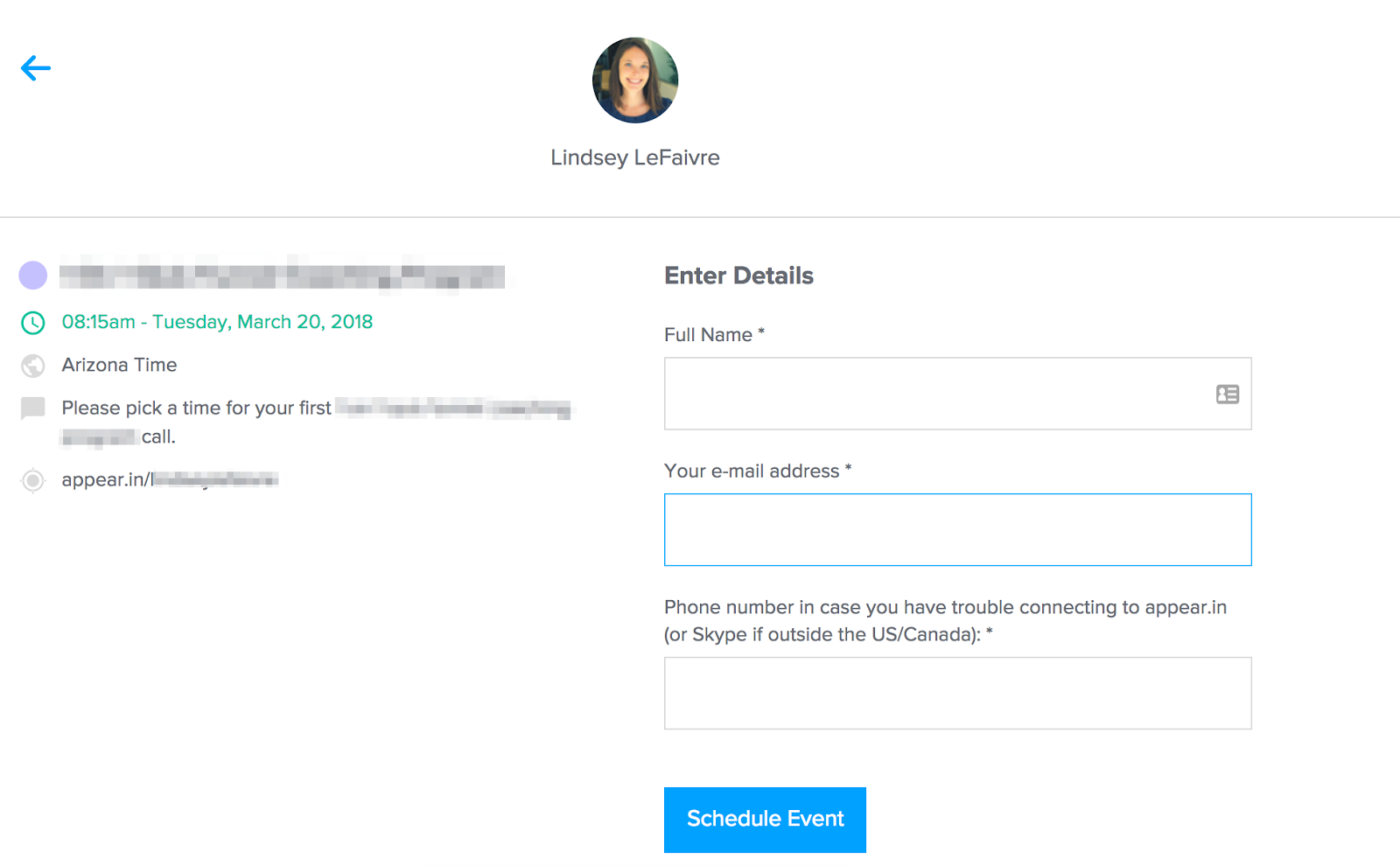
Next, we send them a contract via EchoSign or Docusign and tell them they MUST sign before their first call can begin. This is extremely important so they completely understand what they are getting into and you have it in writing in case there is ever a dispute before you start their work.
After that, we add them to a templated Basecamp project (more on this later).
Finally, we update our internal sales tracking and add the sale on a public whiteboard or ring a bell because it’s great for the morale of the whole team 🙂
Section 7: Before You Write the Quiz
The first and most important part of fulfilling a quiz service to your clients is getting a quiz created for those clients.
And not just any quiz, but one that is high converting, and will help them obtain their goals, whether that is generating more leads and sales, or having more content on their site. To do so, you need to make sure you’re using one of the best online quiz creators out there.
When we first started working with clients on quizzes. We thought, “Hey they are the experts. They will probably write a better quiz then us. Right?” Well, that is what we thought… and we were WRONG.
We quickly discovered that when a client writes their own quiz the time to get the quiz created gets drawn out and while they are the experts they didn’t have a way of creating a quiz that was designed and geared towards lead generation.
So what did we do? We took what we tested and learned what worked best then used that model to create quizzes for our clients, which I’m going to outline below. P.S. We turned some of the best-performing quizzes into free quiz templates available to all of our users.
Collecting Necessary Credentials and Information
To help keep everything organized it’s best to set up a project space for your client. This could be using Basecamp or something as simple as ClickUp.
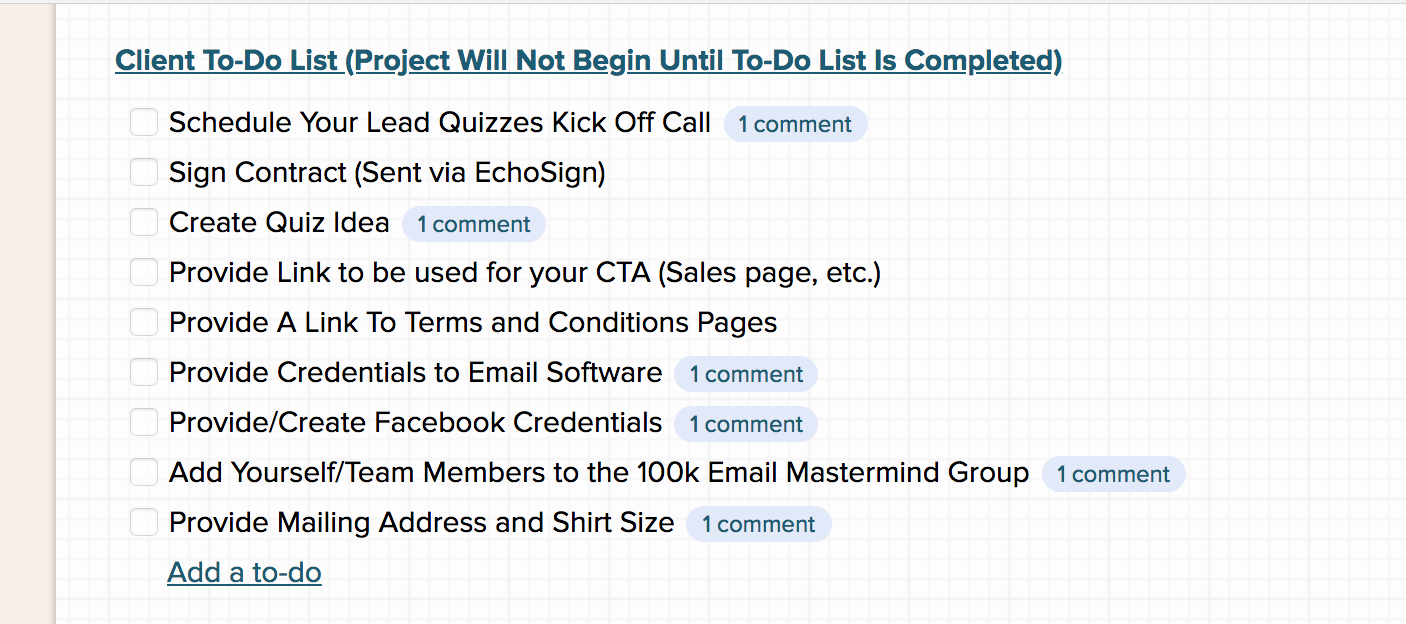
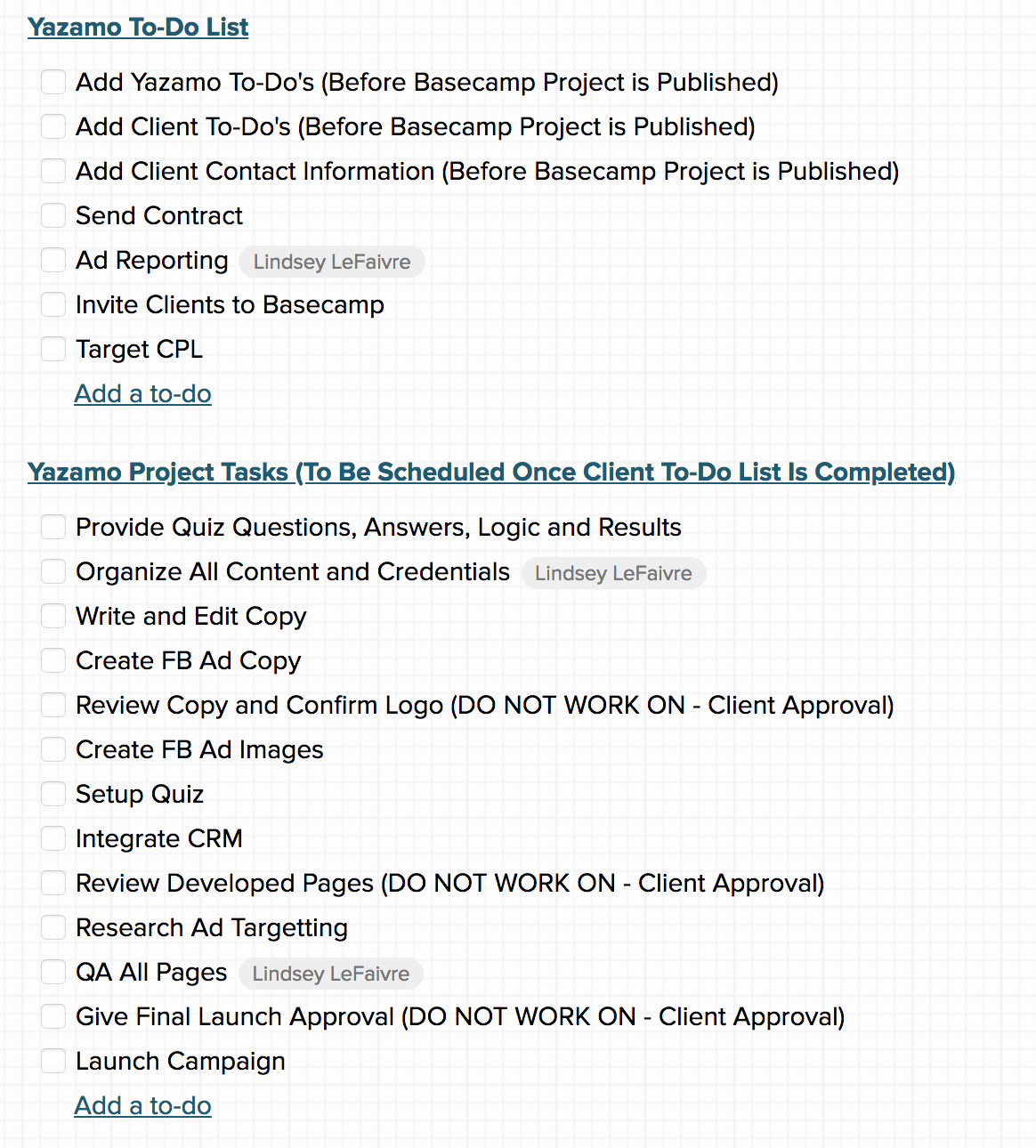
You’ll want to break down the different things that you need from the client into tasks, as well as the things that you will be doing so the client is always on the same page.
Some items you will need when creating a quiz for the client are:
- For them to schedule a kickoff call with you
- Their CRM, email marketing software or Zapier credentials so you can connect the quiz to their autoresponder (here’s some bonus autoresponder swipe copy).
- The sales or offer page that they want to drive people to after the quiz.
- Access to their Facebook page, Twitter, Pinterest, etc. (if applicable for running ads on those platforms)
- A link to their website so that you can match the colors of the quiz to their branding.
- Any photos they might want to use throughout the quiz
Some tasks for you to add (so the client can see what is getting done) are:
- Write the quiz
- Load the quiz into LeadQuizzes
- Connect the quiz to their email marketing software or CRM
- Add advertising pixels to quiz
- Create ads (if you are going to run ads)
- QA and test prior to launch
- Launch quiz
- Update tracking sheet (to be done on a weekly basis)
Creating a project space will also help you to organize all communication with the client and if you have a team of people you can give them all access to the project so if the main point of contact is out of the office things can still get done.
We’ll go over all of the items in the checklist and when they should be completed later on in the training.
Using the Offer to Decide on Your Quiz Topic
Now it may seem backwards but the very first thing you need to do when you get a client who wants to do a quiz is find out what the offer is going to be before you even write one question or come up with a quiz topic.
Now the offer could be a variety of things, from a free consult call to discuss your fertility to a pdf guide that teaches you how to do an exercise or a physical product like a watch with your favorite sports team logo on the face.
Whatever that offer is, it is going to help shape the quiz, because if you want the quiz to be a success the offer has to be enticing at the end. The last thing you want is a, “Where should I travel?” quiz that goes viral, that leads to a thyroid health consult. They aren’t connected and you will see a terrible conversion rate (if you even see one at all).
Versus a “Is your diet helping or hurting your thyroid?” quiz that maybe doesn’t go as viral, so you don’t get as many leads, but the leads are higher quality for your consult because they expressed that they are concerned with their thyroid by clicking on the quiz that ties into the offer.
After you know the offer it’s time to come up with a good quiz idea.
No matter what the product, service or offer at the end of the quiz there are a few rules of thumb to follow:
- Make sure the quiz topic is something people understand. Avoid overly complex wording or scientific terms (unless they are common knowledge).
- Make sure that you can answer the quiz title or what you promise the quiz will do. So if the quiz is “What should I eat for dinner tonight?”, tell them in the results!
- Don’t recreate the wheel. Do some Google searches for quizzes on your topic to see what is working for other people.
For some inspiration here are some of the quiz ideas that we used (and saw great results with!)
- Do you have what it takes to be successful in business?
- How well do you care for your horse?
- What are are you struggling in with your marriage?
- Are you ready to go paleo?
- Is your wardrobe really you?
- Is it time for a personal trainer?
- How fertile are you?
- Are you at risk for gut disease?
- What Phoenix neighborhood should you live in?
You can also check out this article we wrote on How to Make a Buzzfeed Quiz That Goes Viral or this one on 8 Quiz Ideas Your Audience Will Love.
Deciding on the Offer and Interviewing Your Client
Once you have the quiz topic you need to come up with the questions and the outcomes. The easiest way to do this is to sit down and interview your client on a kickoff call.
Prior to the kickoff call, you should collect as much information as possible so the call doesn’t turn into a multiple hour long ordeal. The call should take no more than one hour!
To get them thinking about what they want before you interview them on the kickoff call send them this document to fill out.
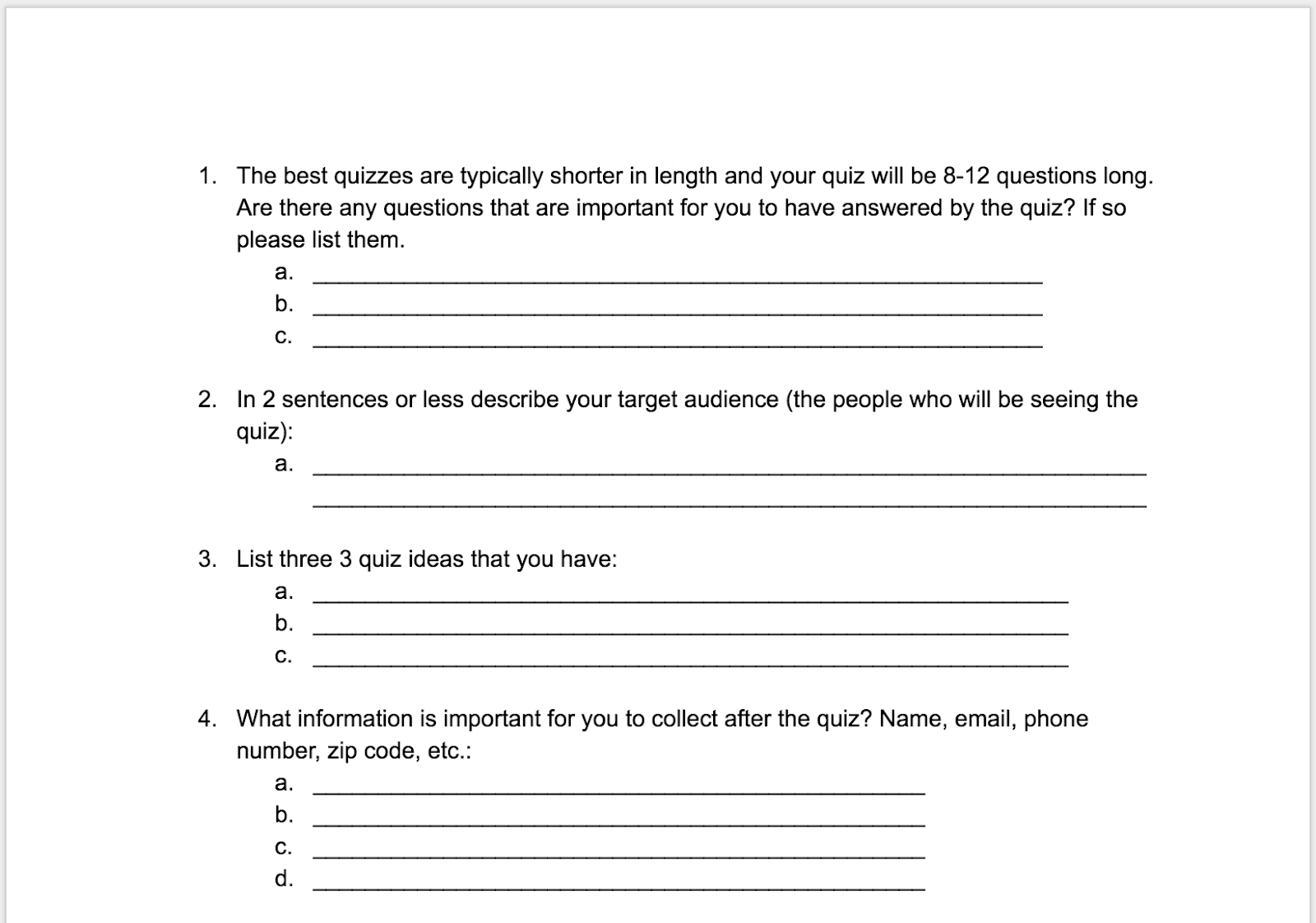
It will give you a solid foundation for what they want and allow you to better control the conversation.
During the interview find out why their product or service is valuable to someone. What are some of the things that people come to them for help for? What symptoms are they trying to alleviate or hope to get from working with them?
By doing this they essentially write the quiz for you, but you are the one that organizes it and turns it into a high converting quiz.
The types of questions you will want to ask are:
- What are some of the problems people are facing when they come to you? (this is good for health or service related industries)
- Have they tried other solutions and they don’t work?
- Is it important for you to know the gender of the people who take your quiz? (if so you can add an easy question at the start of the quiz like “Are you male or female?”)
- Why is your product/service better than your competitors?
The goal is to learn about who the ideal audience is for the quiz and then tailor the quiz towards their needs.
Here is a basic outline to help you guide the call:
First 10 minutes – confirm with the client what they prefiled in on the document here.
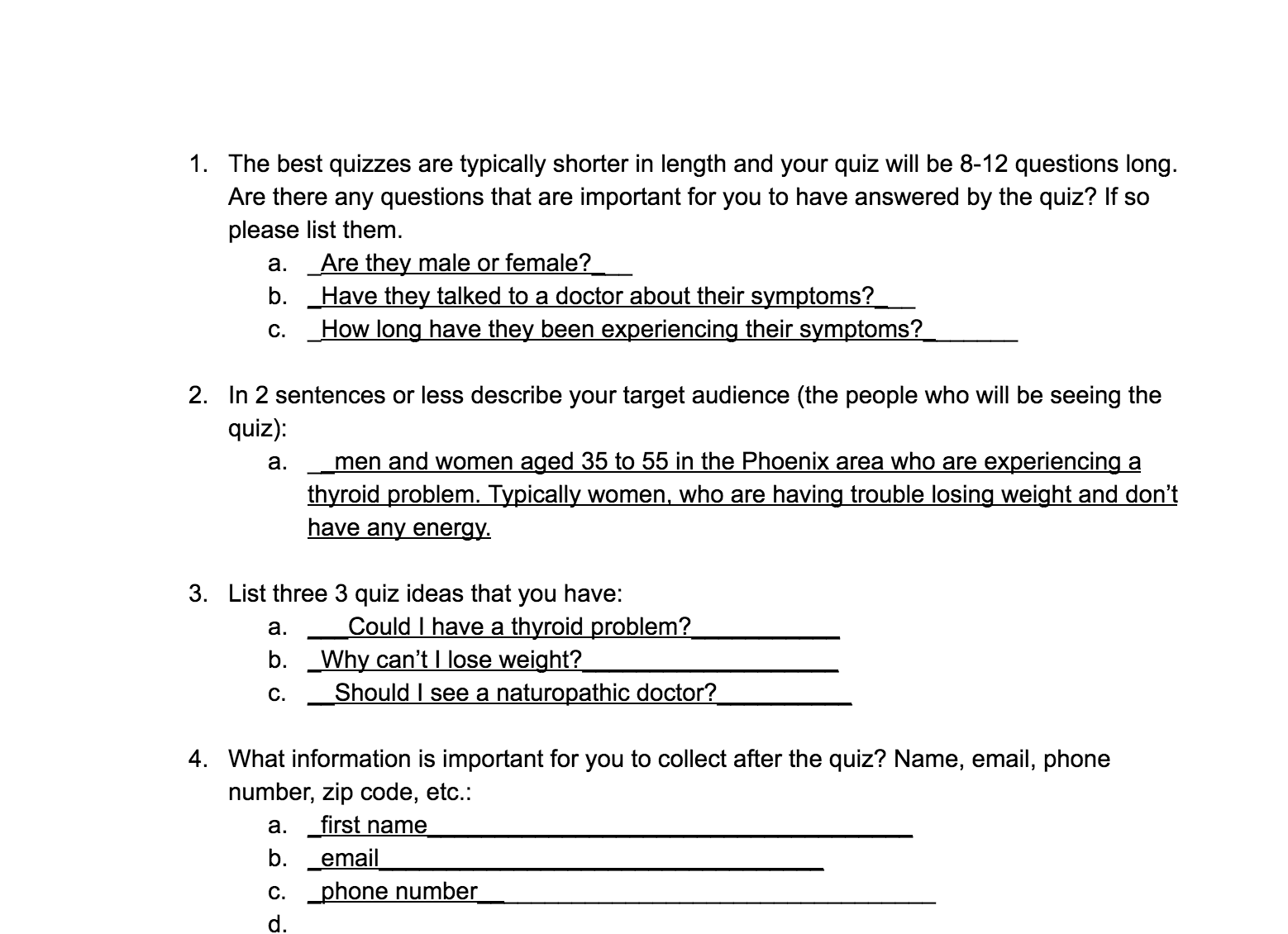
Sometimes you will find out what they put on the doc is not what they really want so use the first 10 minutes to really make sure that this is what makes the most sense for them.
The next 15-20 minutes should be spent going over the above questions, like why do people come to you for help with this, or why is your product/service better than your competitors. Here you should be able to get information to write 80-90% of the quiz questions.
The next 15-20 minutes should be spent going over the outcomes or results and information the client would like to see there, as well as informing them what works best. Keep in mind you only want a few paragraphs here and the goal is to get the quiz takers to go to the next step in the funnel. Whether that is scheduling a consult, purchasing a product or opening their email.
For the last 10-15 minutes, you should do a quick summary of what you went over with the client, give an expected time frame for them to get the get initial quiz as well as ask if there are any questions that they have.
Section 8: You Have a Topic. Now Let’s Write the Quiz!
After your kickoff call, you should have everything you need to write an amazing quiz!
Based on the topic and title of the quiz you will be able to come up with your results.
We recommend 2-4 results to keep it simple, but you can always create more if needed!
Remember the results should answer what the main quiz question, or title is.
So if the quiz is a “Am I at risk for gut disease?” quiz, then the outcomes should be “High risk for gut disease”, “Moderate risk for gut disease” and “Low risk for gut disease” (or something similar).
The outcomes should be short, yet valuable, typically 2-3 paragraphs is all you need, just make sure that there is a call to action that leads to the sales or offer page.
Once you have the outcomes set then it is time for the questions.
The ideal quiz should have 8-12 questions. This is really the sweet spot, it’s not too many questions where it takes too long to complete and it’s not so short that they don’t think they will get valuable feedback.
When you are writing the questions some things you want to stay away from are situational based questions and anything that has a long answer.
Answers should be short and concise (and so should the questions!)
The best types of answers are yes, no, sometimes, maybe, always, never, etc.
The reason for this is they are easy to answer and someone is able to get through the quiz within 1-2 minutes.
We don’t want a quiz to be too long because something can come up in the middle of the quiz and a quiz taker abandons it, or if the quiz is taking to long they might abandon it because they are getting bored. The same goes for if it is too short. If it’s too short it is often assumed you won’t be providing valuable feedback.
Here’s some great additional reading on what makes a high performing quiz.
With this in mind and your client interview completed it’s time to write the quiz.
Here are some examples of questions that have worked well:
- Are you male or female?
- Male
- Female
- Prefer not to say
- How long have you been experiencing (insert problem i.e. back pain)?
- Just in the last few months
- Within the last 6 months to a year
- More than a year
- Do you experience (insert symptom i.e. fatigue)?
- Yes
- Sometimes
- No
And our in-depth guide on how to make a quiz on our homepage, should help with the writing process if you get stuck at all.
Once you have the quiz written you’ll want to send it to the client for feedback and any changes they might have. I recommend having a set number of iterations that you can do for each client. Typically I limit it to two, but most times you only need one round of changes.
I recommend using a Google doc, like this one to send the quiz to the client.
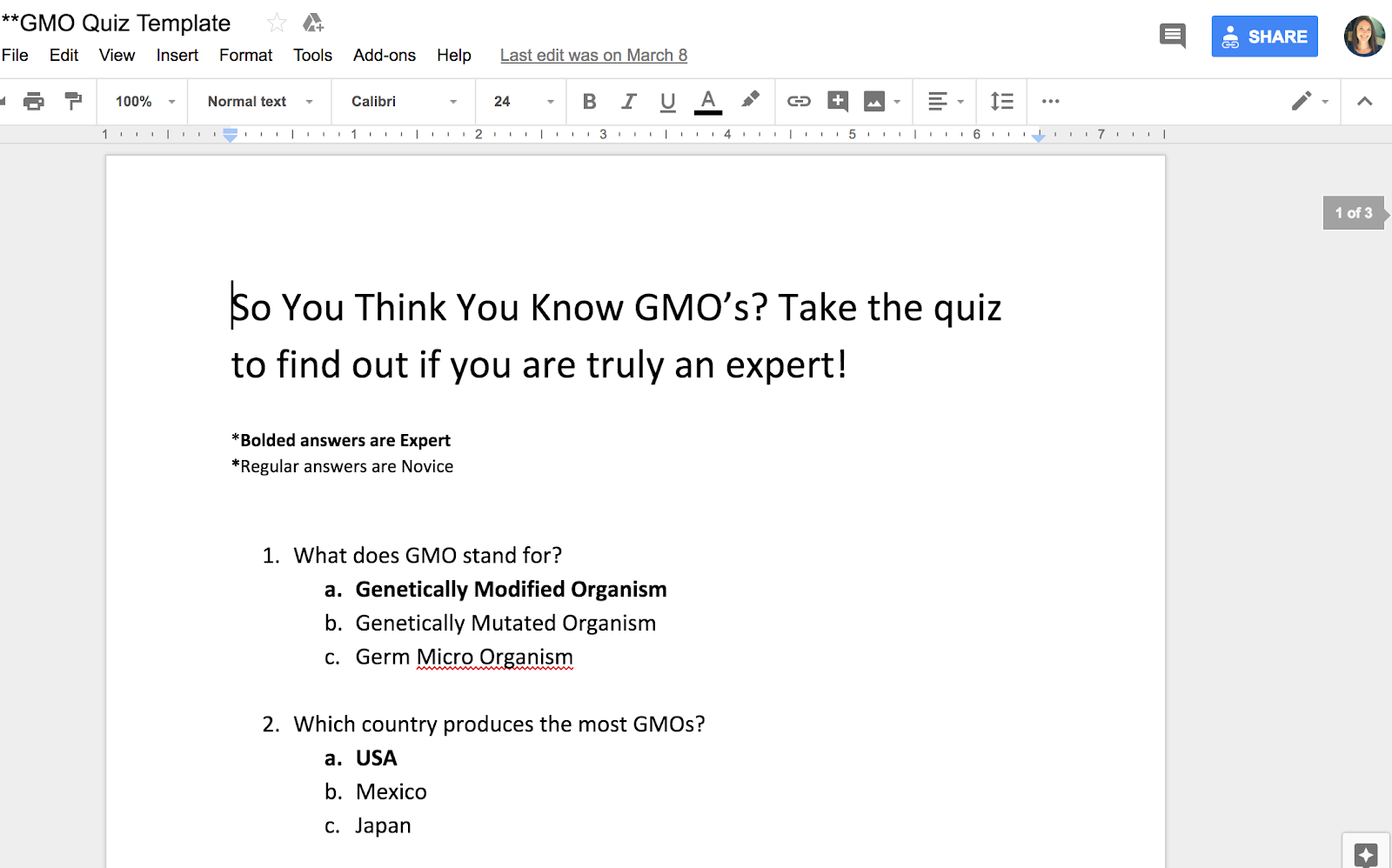
Set the document where they have comment access and not edit access. This will make it easier for you to see where they make changes.
Once you update the changes. Confirm with the client and you can start loading the quiz into the software!
Things to Remember When Uploading the Quiz
Since you already wrote the quiz out in a Google doc it should just be a matter of copying and pasting into the software, adding the advertising pixels, and connecting it with the client’s CRM or email marketing software of choice.
Here are some things to check before you send the finalized quiz to your client for review:
- The quiz is connected with their CRM or email marketing software and the leads are being added to the correct place
- The advertising pixels are in place and firing correctly
- Some ways to check this including having Google Tag Assistant, Facebook Pixel Helper, and Twitter Pixel Helper installed on your Google Chrome browser
- All of the questions answers are mapped to the correct outcomes
- The colors of the quiz match the clients branding (if applicable)
- The sales or offer page is linked and working on the results pages (if applicable)
- The images and videos used through the quiz are ones that match the clients wants and needs as well as the target audience
- All results, questions, and answers have been QA’d for any spelling errors
After you’ve gone through the quiz and ensured it’s ready to go send it off to your client to review before it goes live.
After their approval, it’s time to get the quiz added to their website as well as set up any paid advertising they might be doing.
Section 9: Adding the Quiz to Their Website To Drive Traffic
Adding the quiz to your client’s website is one of the easiest ways to give them that instant gratification of having an awesome quiz that collects leads as well as an amazing piece of content.
You can add the quiz in multiple places and below are a few suggestions to help you get started:
- Use HelloBar to add a little banner at the top of their homepage.
- Create a call to action to that clicks to the quiz and place it ABOVE the fold on the home page (not keeping it above the fold is one of the biggest mistakes I see people making)
- Embed it directly on applicable blog posts
- Add a call to action in the sidebar of your website
- Add the quiz to your main website navigation
You can do a combination of these things, or all of them! But I highly recommend you add the quiz to your client’s website so they get that instant gratification!
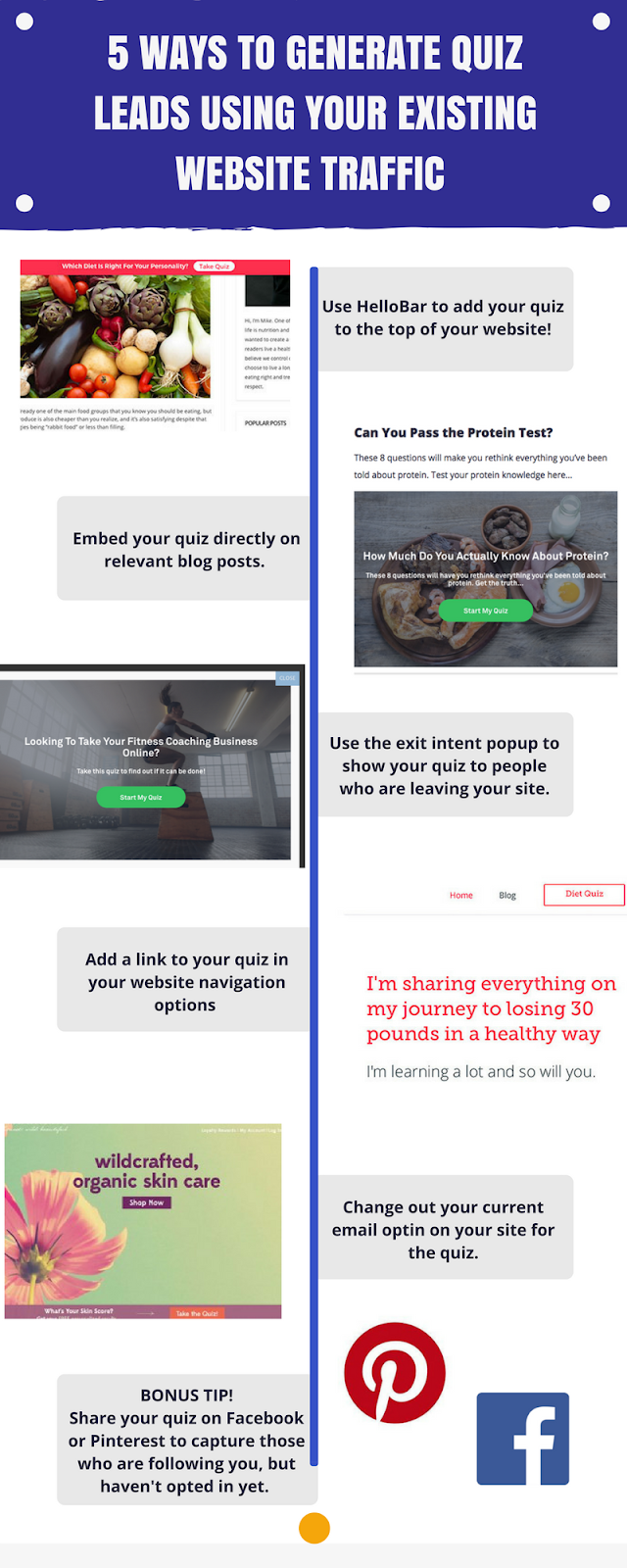
Section 10: Ongoing Ad Management and Recurring Revenue
While giving your clients that instant gratification is an amazing feeling. It is even better when you have them on a recurring revenue retainer, and the easiest way to do that is through ongoing ad management.
This can be in the form of Facebook ads, Instagram, Google Ads, Pinterest, Twitter and more.
If you are going to be running ads there are a few things you need to know.
First it’s very important to have a contract with your clients!
In that contract outline things, like the max ad spend for the retainer, how often reporting will be updated, how often you will have meetings with them to discuss the ads, and the types of ads you will be running.
This is important for not only setting the right expectations for your client, but will help you to have a clear boundary line to make sure you don’t get taken advantage of 🙂
Keep in mind that the more ad spend, different types of ads, and added advertising platforms are all things that will take more of your time, so you will want to price your services accordingly.
When we were scaling our ad services we tested a number of price points and found, $1,000 a month for up to $7,500 a month in advertising spend, advertising just 1 quiz on Facebook and Instagram worked the best.
And if our clients wanted we could add on other services, such as other advertising platforms, or different types of ads for an additional fee.
But the bread and butter was $1,000 a month.
For this pricing, we completely managed and updated the quiz ads for them. We provided weekly reports with stats on how the ads performed and monthly calls to go over everything. Additionally, we provided coaching on how to convert those leads into sales and paying customers.
As mentioned before, if you have a really tight niche and are able to template additional things for your client like autoresponders, sales scripts etc. you should provide those. Anything you can do to help them increase their sales in a scalable way, you should help with.
Setting up the Ad Account
Once you have the contract set the next thing you will need to do is set up an ad account for the client under your Facebook business manager. It’s important to create a different ad account for each of your clients for a few reasons:
- It allows you to have complete control over the ads you are running and ensures your clients don’t interfere with anything you are running
- It protects your other client’s ads because if one of them has an ad that gets disapproved or an ad account banned it won’t prevent you from running ads from your other ad accounts
- It allows for the ad spend to be paid directly by the client to Facebook and makes it easier on you, versus paying for it yourself and manually tracking it to make sure the client pays the correct amount
Once their ad account is set up you will need to create a pixel for that account within Facebook.
This pixel will be added to the quiz, so you can optimize for quiz leads, and should also be added to the sales/offer page if applicable, as well as the thank you page they would go to after that so you can easily track conversions.
After the pixel has been added to the applicable places you will want to go through and test all of those pages to ensure that the pixel is firing.
I recommend using Facebook pixel helper (available as an extension for your Chrome browser), which will verify the pixel is firing correctly.
Once you have verified the pixels are firing it is time to create custom conversions within the Facebook ad account so you can track when that pixel fires for specific events, such as someone opting in for the quiz, going to the sales page and purchasing. This will help you to better show your client how well the ads are performing on your weekly reporting sheet.
The custom conversions you will be creating are for the quiz URL (even if you are driving traffic to the quiz embedded on a different page), the sales/offer page, and the thank you page.
To set up these custom conversions just click to “Custom Conversions” under “Measure & Reporting” on your ads manager for the client’s ad account and follow the steps.
After the Custom Conversions are created you are ready to create the first ad for your client!
The most important thing in creating these ads is making sure that they are optimized for the correct thing.
In most Facebook ads you might optimize for clicks, but in this instance you should be optimizing for “conversions” and in this case the conversion you will be optimizing for is the custom conversion you created for your quiz.
By optimizing for this you will be telling Facebook that the most important thing for you is conversions and getting the best conversion cost, versus clicks and people just going to the quiz.
Some things to keep in mind when you create these ads are:
- Let your ads run for at least 24 to 48 hours, or 1,000 impressions before you turn them off or change them so you know how well they are actually performing.
- When you are looking at performance and updating your clients make sure to look at FULL days. For example, if you run ads for March 1st to March 7th, you won’t want to pull those stats until the 8th so that you can look at the entire day of the 7th. If you pull stats for the same day in the middle of the day then reporting can get messy very quickly.
- Try to match the image on your quiz start page with the image you are using in your ad, as well as the copy. You want to make sure there is a good flow from one to the other.
What to Track and Report to Clients
When it comes to providing your clients with the results of their campaigns there are a few very important things that you need to look at and provide them feedback on.
There are numbers you should get from LeadQuizzes, from Facebook ads and from your client.
First, let’s talk about the numbers you need and then we will talk about where to get them.
- The number of leads generated in the week
- The number of clicks to the quiz
- The number of leads who go on to the sales/offer page
- The amount of money spent on the ads
- The number of purchases (or offer takers)
![]()
Those are the 5 basic numbers that you need and there are a few more you can get if necessary, like CTR, but I would start with those.
Now where to get those numbers and what to do with them.
For leads generated it is best to get this number directly from LeadQuizzes. The number may be off slightly from Facebook, because the Facebook pixel can sometimes not fire when it is supposed to. It should be pretty close, but to ensure accuracy check the lead number in LeadQuizzes!
For clicks to the quiz, I look at link clicks in Facebook. It is important to look at “link” clicks and not all clicks. “All clicks” is any sort of click on your ad, but not necessarily clicks to your quiz. So someone clicking to read your ad could count as a click!
For leads who go to your sales or offer page, I would recommend using a Bit.ly or trackable link in your results that goes to your sales or offer page and look at the number of clicks you have on that link. You can also look at the number of conversions in Facebook to that page, but using a trackable link and checking the stats there will be the most accurate!
For the amount of money spent on your ads, you will want to get this from Facebook (or whatever platform you are advertising on). Just be sure when you get this number you are looking at full days! (The same applies for all of the above numbers)
Lastly, for the number of sales or offer takers, you will want to get this number from your client. Make sure that they have a way of tracking this. It could be through a tag they apply in their CRM, looking at total sales for the product during that week (if no other traffic is going to it) or something as simple as recording who takes them up on the offer in a Google spreadsheet.
Now that you have all of these numbers you will want to record them in a Google spreadsheet that is unique to that client. Here is a template that we use to get you started.
You can choose how often you want to update this sheet for your clients, but I recommend you update it once a week.
After the sheet is updated, send a message to your client letting them know how the campaign performed the past week and things you will be testing the following week.
You can also go over tests to run for the month on your monthly check-in calls. These calls are also great opportunities to see if there are other areas of the funnel that you can assist the client with like optimizing their landing pages, their email follow up sequence or improving their sales process.
Once you know what they need assistance with think of ways to offer those services and use them as upsell opportunities!
Retaining Your Managed Clients
Now just because you are running paid ads for a client doesn’t mean that client is going to stick around forever. In order to do that you need to make sure that they’re getting the results they desire!
And this can vary from client to client, most are going to want to generate leads and sales and you may need to help on the sales side in order to keep them on longer.
I’m not saying to get on the phone and actually try to make sales for them but you should try to find scalable ways to help them optimize their email campaigns and sales process. Picking a niche helps a lot here.
Some things that we look at for our clients are email open rates. Is the first open rate high, but then there seems to be a drop-off? Or maybe the first open rate is low.
If the first open rate is high, that’s great, it means you are doing your job of bringing in leads and getting them to take action! But if the subsequent open rates are low then you may want to look at the first email, what its asking and if it comes across as overly salesly. If it does tweak it so that it adds more value.
Try avoiding asking for a sale in the first email and just tell them about who the client is and why the are passionate in what they do. That will introduce them and give them a chance to start a conversation before they ask them to buy something.
If the first email open rate is low then you will want to look at your results pages and the lead capture page. Is it clear that you will be emailing them? If not make it clear!
Also look at the subject of the first email, is it clear that it is from the quiz? If not make it clear! Some good subject lines include:
- “Your Quiz Results!”
- “More Information About Your (Insert name) Quiz Results!
- “Thanks for taking the quiz. Here’s your bonus!”
If you are able to get the email engagement up, then odds are you are going to help the client get more sales and a more engaged following.
Here is some swipe copy for you to help your clients get going.
We used this very exact email sequence to generate not only tens of thousands of dollars for our agency, but for our clients as well!
If the email open rates and engagement are good, but the client still isn’t getting any sales then it is time to look at their offer.
It could be that the offer isn’t enticing, or it doesn’t match the needs of the client.
Look at testing the price point of the offer as well as the delivery.
Maybe instead of using a sales page, you use a webinar or offer a consult call where they can sell over the phone.
Once the offer is converting and the leads are coming in you should have them as a client for a very long time!
We still have some clients that we have been working with for almost 3 years now!
Section 11: Scaling Your Agency by Hiring Ads Managers and Account Managers
Just like with sales you will probably get to a point where you can’t handle all of the ad and account management on your own and you need to hire so you can continue to scale.
We found it was best to have an account manager who worked one on one with our clients, writing their quizzes, looking at ways to optimize their funnels and serve as a liaison between the ads manager and the client. Then we had an ads manager who worked on managing and optimizing the clients Facebook ads.
This allowed our account managers to focus solely on the client and our ads manager to focus on the creative side.
Each account manager and ads manager could effectively handle 25 to 30 clients. (occasionally you’ll get someone who can do more, but expect 25 to 30).
It’s crucial that these two positions work closely because if the account manager doesn’t know how effective the ads are in bringing results for the client, whether that be sales or simply growing their list, then the ads manager isn’t able to make the correct adjustments.
We found it was important for the ads managers and account managers to sit down in a 30 to 60-minute meeting each week, to go over each client’s results and what would be tested the following week to improve on those.
The ads manager was then able to relay this to the client in their weekly ad update and on their monthly calls.
Managing Your Account Managers
The easiest way to measure how good of a job your account managers are doing is the average retention of their clients.
The longer their clients stay with you typically the better job that person is doing. Now, this isn’t to say that your best account managers will never lose a client, that is bound to happen from time to time, even if they are doing everything the should be doing and more.
Have them keep track of how long their clients stay on, how many calls they have with that client each month, what their average lead cost was per month for that client and how many sales the client got as a result of the ads. This will not only help you to see how well your account manager is staying on top of their clients, but it will help you to build more of a baseline for the type of results you can produce for your niche.
We recommend a short 30-minute check-in meeting with your account managers each week to see if there are any areas they are struggling in, such as getting a client on the phone or getting them to disclose sales numbers. It gives you the opportunity to see how your account manager is doing and also helps you to see if your sales team are closing the right type of clients that you can get results for.
Managing Your Ad Managers
Running ad campaigns is all about the numbers, which makes it easy for you to see if your ads managers are meeting expectations.
Once we started working solely in the health industry we had a pretty good idea for what lead cost should be and were able to manage our ads team a lot more efficiently.
For each new client that they received, we had them give an estimate for lead cost, based on previous campaigns they had run and what the averages were that they were seeing in that industry. Once we had that, we used it as their weekly metric and expected for them to have at least 80% of their clients in this goal range within the first month of managing that campaign.
We knew from running ads that it can take a couple of weeks to optimize which is why we gave each ads manager 1 month to get within goal range and occasionally you would have local campaigns that for whatever reason just wouldn’t perform as well as expected, so 80% was a pretty fair number.
Just like with our account managers we meet with our ads managers once a week for 30 minutes to go over their numbers, areas that they are struggling and to see if there have been any changes in the ad platforms we were running on so we could adjust things on the sales calls.
Training for your Ads Managers and Account Managers
Since our ads managers and account managers work so closely together it’s important that they each have a solid understanding of the other ones job, this is why we required all of our account managers and ads managers to learn how to run Facebook ads and be familiar with the advertising guidelines.
Ads managers obviously go deeper with the training, but by having them all go through the training our account managers were able to write better quizzes that were Facebook compliant and our ads managers were able to avoid a lot of back and forth in regards to what could and couldn’t be done.
Facebook’s Blueprint course is what we used and we highly recommend it. It gets them familiar with the Facebook platform if they haven’t used it extensively and they can go through it at their own pace.
We also required our account managers and ads managers to shadow each other for a half a day during their first week of training, including listening in on a client call and writing a quiz so they knew the process and where their part fits into the funnel.
Section 12: Conclusion and Next Steps
And that’s how we turned around our agency, sold 189 clients and built it to $720,000 per year.
✅ We figured out how to control our own lead generation.
✅ We figured out how to get consistent results for clients.
✅ We figured out how to productize our service so that we didn’t have to spend a lot of time developing proposals.
✅ We figured out how to work with a larger number of clients at a lower price so that no one client would become a huge risk for our business.
✅ And we figured out how to be able to easily train our team and really scale our business.
As LeadQuizzes grew, we felt a strain between investing more in our software and investing more in our agency. We thought we could keep growing both but as a bootstrapped company we just didn’t have the manpower to focus and invest in both. Ultimately we choose to focus on our software and let our agency work go.
This decision, however, works out well for you as we now have a mission to help support other agencies in growing their business and picking up where we left off.
Here’s how we can further help your agency grow using LeadQuizzes:
- We are here to support you! Whether it is a question on creating a quiz, you aren’t sure about targeting or you need some suggestions on where to add the quiz to your clients site we are just a chat support message or phone call away.
- We can help drive leads to you by featuring your case studies on our site, which gets over 720,000 yearly website visitors.
- As you provide us with case studies, we will work with you to become a certified LeadQuizzes partner and develop a featured agency page on our website for our leads to hire you.
- You will get VIP access to guest blog for our site to drive leads to your business.
We hope this guide has been helpful!
I would love to hear what your biggest takeaway was or what YOU would have done differently. Please leave a comment below 🙂